Winter in Minnesota transforms the landscape into a snowy paradise, creating a picturesque backdrop for birdwatching.
Despite the cold and often harsh weather conditions, a remarkable variety of bird species make the state their year-round home or their winter retreat.
From bustling cities to serene wilderness areas, Minnesota’s diverse habitats host an array of birds that add color and life to the winter scenery.
Bird enthusiasts and casual observers alike have the opportunity to spot these avian visitors, each with their unique behaviors and adaptations to the chilly climate
47 Winter Birds In Minnesota
Winter in Minnesota offers a unique opportunity to observe various bird species that either reside year-round in the state or visit during their winter migration. Here are 47 birds commonly seen in Minnesota during the winter months:
1. Northern Cardinal (Cardinalis cardinalis)
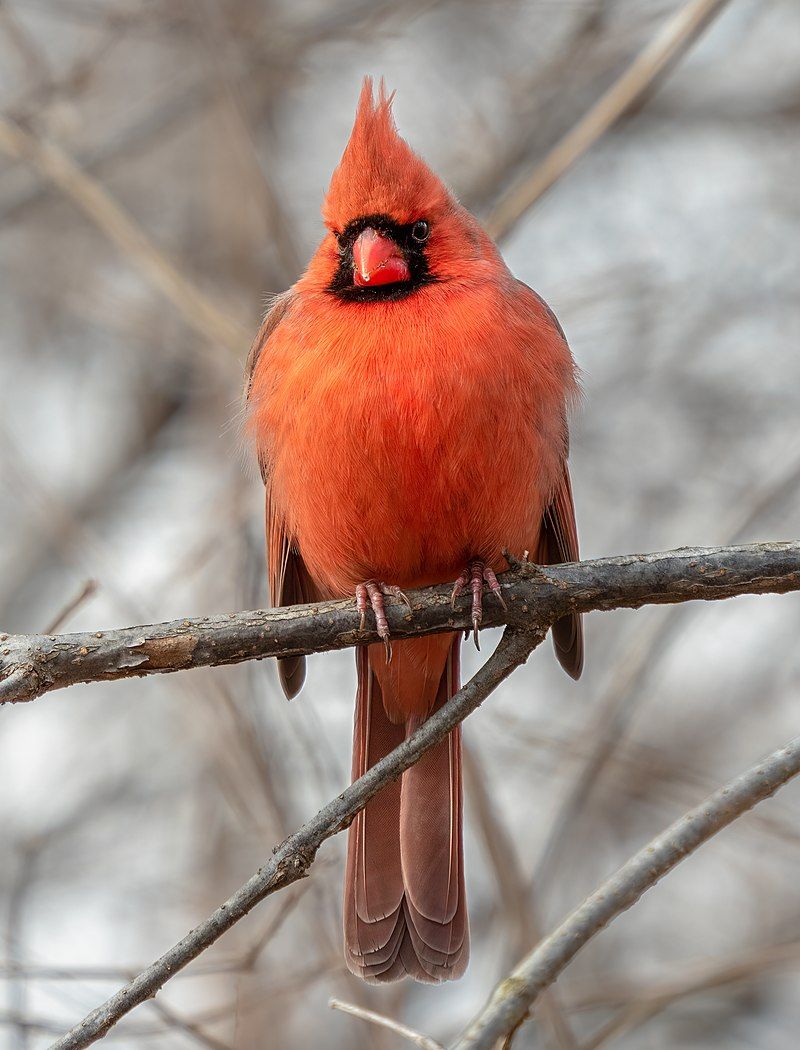
The Northern Cardinal, scientifically known as Cardinalis cardinalis, is a vibrant and easily recognizable bird native to North and South America.
This bird is famous for its striking red plumage, prominent in males, while females display a more subdued mix of gray and red.
Northern Cardinals are medium-sized songbirds with a distinctive crest on their heads and a robust, cone-shaped bill suited for seed-eating.
They are non-migratory birds, often found in woodlands, gardens, and shrublands. Known for their melodious songs and calls, both males and females sing, which is relatively uncommon among songbirds.
Their diet mainly consists of seeds, grains, and fruits, but they also consume insects.
| Kingdom | Animalia |
| Phylum | Chordata |
| Clade | Dinosauria |
| Class | Aves |
| Order | Passeriformes |
| Family | Cardinalidae |
| Genus | Cardinalis |
| Species | C. cardinalis |
2. Juncos (Junco hyemalis)
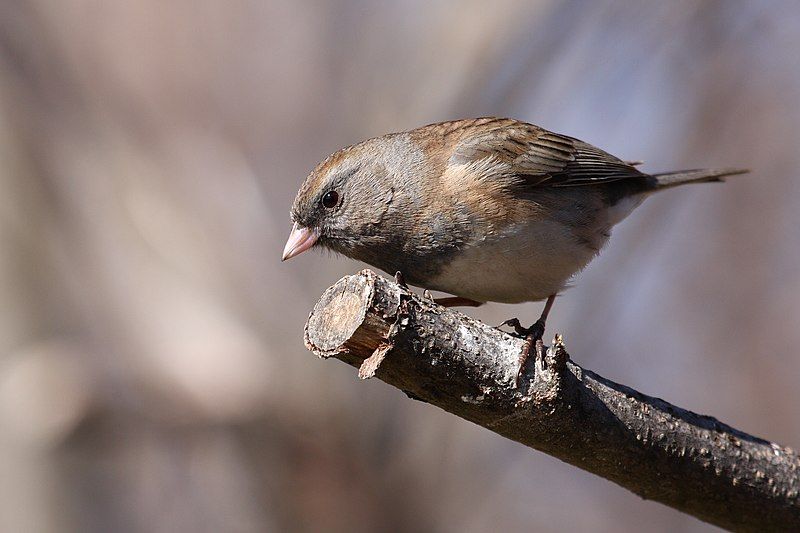
Juncos, specifically the Dark-eyed Junco (Junco hyemalis), are small North American sparrows. This species exhibits considerable variation in plumage, but most are characterized by their slate-gray or blackish bodies and white underparts.
They have round heads, a short, stout bill, and a fairly long, conspicuous tail. Juncos are primarily ground feeders, eating seeds and insects.
In winter, they often form flocks, commonly seen in open woodlands, fields, and gardens. Juncos are known for their distinctive “chip” calls and trilling songs.
Their adaptability to different habitats makes them one of the most common birds in North America, especially noticeable during their migration.
| Kingdom | Animalia |
| Phylum | Chordata |
| Clade | Dinosauria |
| Class | Aves |
| Order | Passeriformes |
| Family | Passerellidae |
| Genus | Junco |
3. Pine Siskin (Spinus pinus)
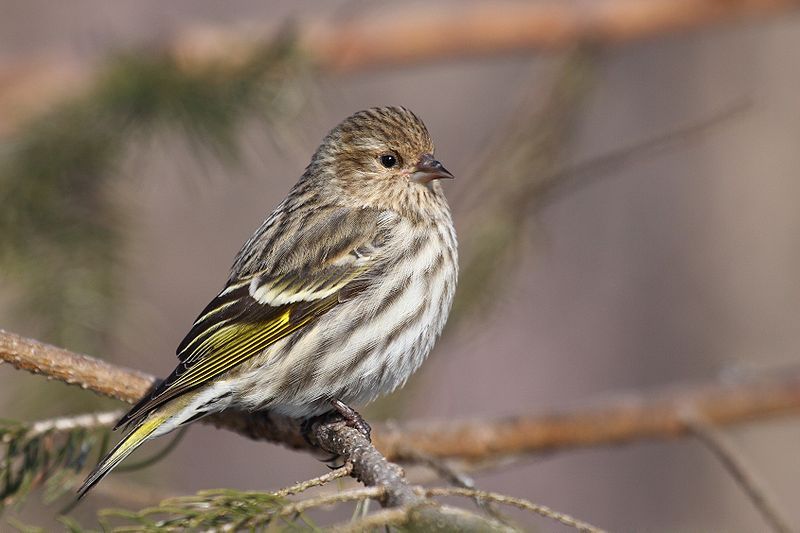
| Kingdom | Animalia |
| Phylum | Chordata |
| Clade | Dinosauria |
| Class | Aves |
| Order | Passeriformes |
| Family | Fringillidae |
| Genus | Spinus |
| Species | S. pinus |
4. American Goldfinch (Spinus tristis)

The American Goldfinch, Spinus tristis, is a small, vibrant songbird known for its striking yellow plumage during the breeding season.
Males are especially colorful, with bright yellow bodies, black caps, and black-and-white wings. Females and non-breeding males are more subdued in color, primarily olive or brown.
These birds are found across North America in weedy fields and floodplains, where they feed mainly on seeds, especially from thistles and sunflowers. American Goldfinches are known for their undulating flight pattern and cheerful, twittering song.
They are unique in their late breeding season, timed to coincide with the abundance of seed foods, and they are the only finches to molt their body feathers twice a year.
| Kingdom | Animalia |
| Phylum | Chordata |
| Clade | Dinosauria |
| Class | Aves |
| Order | Passeriformes |
| Family | Fringillidae |
| Genus | Spinus |
| Species | S. tristis |
5. Cardinalidae (Cardinalidae Family)
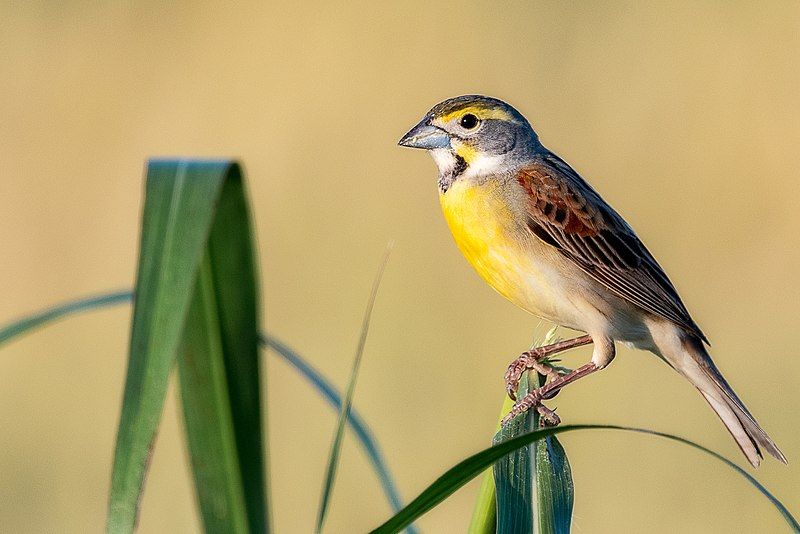
The Cardinalidae family, encompassing cardinals, grosbeaks, and allies, is a diverse group of passerine birds primarily found in the Americas.
Members of this family are known for their robust bills, which are well-suited for seed-eating, though many also consume insects.
This family includes well-known birds like the Northern Cardinal and the Scarlet Tanager, exhibiting a range of vibrant plumages, with males often more brightly colored than females.
Cardinalidae species inhabit various environments, from forests and woodlands to shrubby areas and gardens.
These birds are also recognized for their melodious songs and calls, making them favorites among birdwatchers and nature enthusiasts.
| Kingdom | Animalia |
| Phylum | Chordata |
| Clade | Dinosauria |
| Class | Aves |
| Order | Passeriformes |
| Family | Cardinalidae |
6. Downy Woodpecker (Dryobates pubescens)
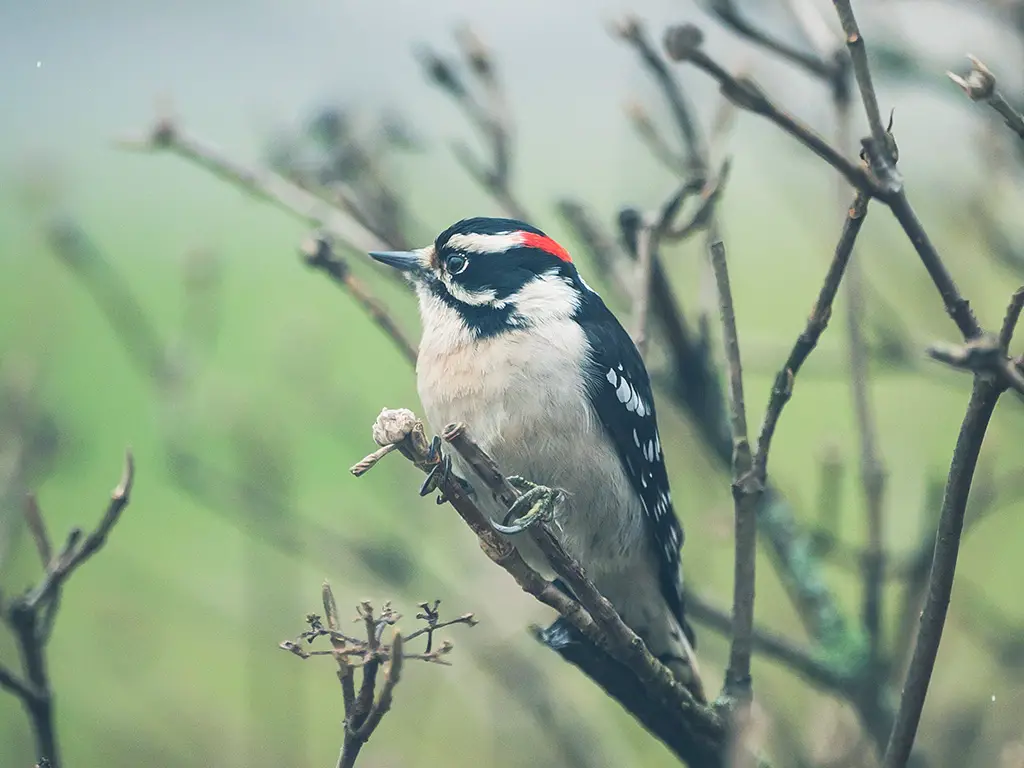
The Downy Woodpecker, Dryobates pubescens, is the smallest woodpecker in North America. It has a black-and-white striped head, a white underbelly, and a black back with white spots.
Males can be distinguished by a small red patch on the back of their heads. These birds are adaptable and can be found in various wooded habitats, including forests, orchards, and urban parks.
Downy Woodpeckers feed on insects, especially beetle larvae and caterpillars, but they also eat seeds and berries.
They are known for their distinctive drumming on trees and their high-pitched whinnying calls. Their presence is beneficial for controlling pest populations and aiding in forest health.
| Kingdom | Animalia |
| Phylum | Chordata |
| Clade | Dinosauria |
| Class | Aves |
| Order | Piciformes |
| Family | Picidae |
| Genus | Dryobates |
| Species | D. pubescens |
7. Cyanocitta (Cyanocitta Genus)
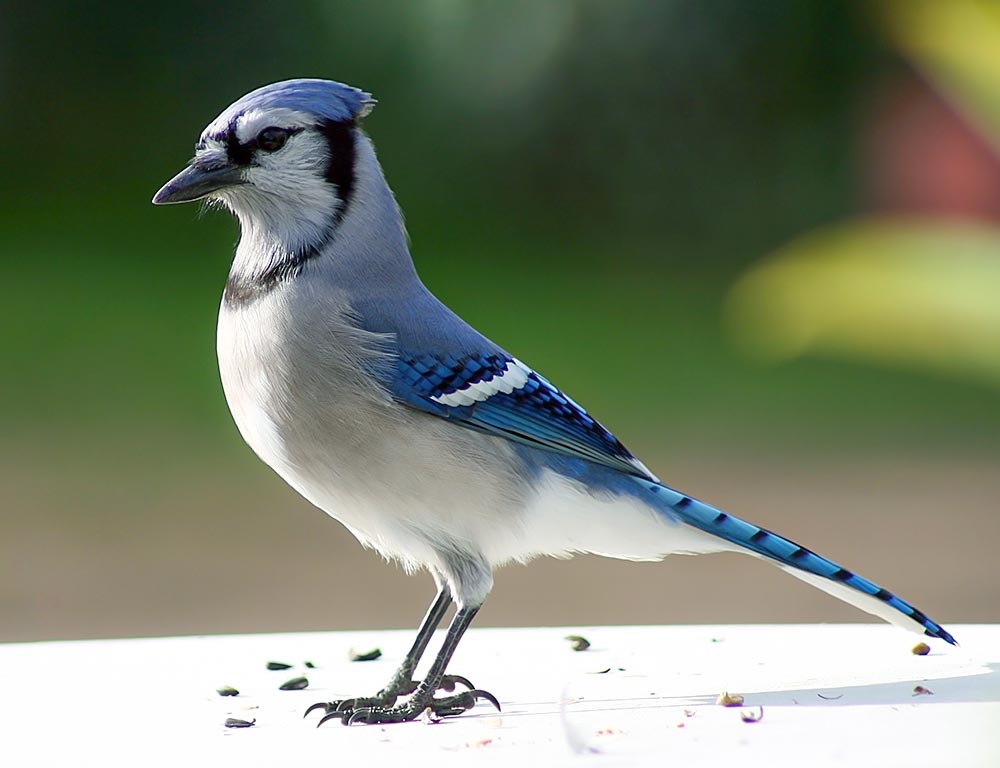
Cyanocitta is a genus of birds within the crow family, encompassing species like the Blue Jay (Cyanocitta cristata) and the Steller’s Jay (Cyanocitta stelleri). These birds are known for their striking blue plumage, loud calls, and intelligent behavior.
Blue Jays, found in eastern and central North America, have bright blue, white, and black plumage, while Steller’s Jays, found in western North America, are darker and have a prominent crest.
Members of this genus are omnivorous, feeding on various seeds, nuts, fruits, and small invertebrates. They are also known for their complex social behaviors, including mimicking the calls of other birds and working cooperatively in groups.
| Kingdom | Animalia |
| Phylum | Chordata |
| Clade | Dinosauria |
| Class | Aves |
| Order | Passeriformes |
| Family | Corvidae |
| Genus | Cyanocitta |
8. House Finch (Haemorhous mexicanus)
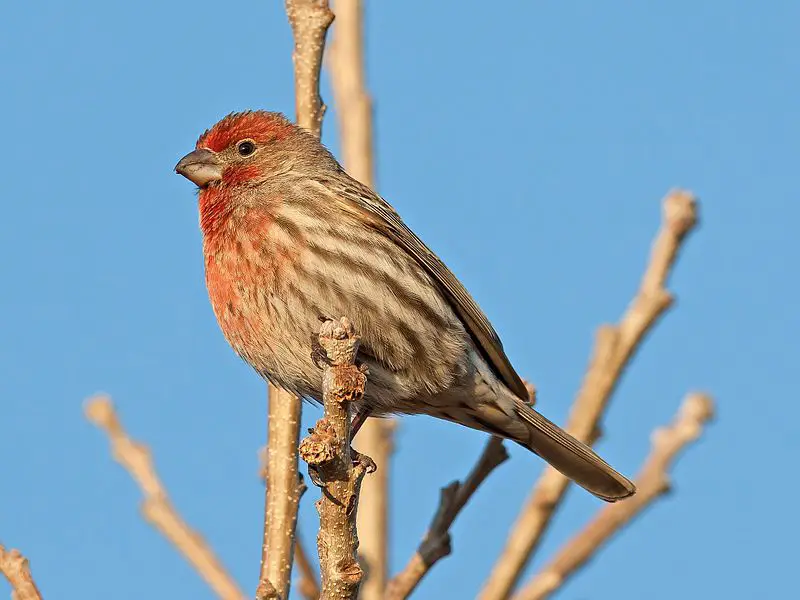
The House Finch, Haemorhous mexicanus, is a small bird that originated in the western United States and Mexico but has since been introduced to the eastern parts of the U.S.
Males are easily recognized by their rosy red heads and breasts, while females are brown and streaked. House Finches prefer urban and suburban areas where they can often be seen around buildings, backyards, and parks.
They primarily feed on seeds and grains but also consume small fruits and insects. Their song is a cheerful, warbling melody frequently heard throughout the year.
The adaptability of the House Finch to human-altered environments has facilitated its widespread distribution.
| Kingdom | Animalia |
| Phylum | Chordata |
| Clade | Dinosauria |
| Class | Aves |
| Order | Passeriformes |
| Family | Fringillidae |
| Genus | Haemorhous |
| Species | H. mexicanus |
9. House Sparrow (Passer domesticus)
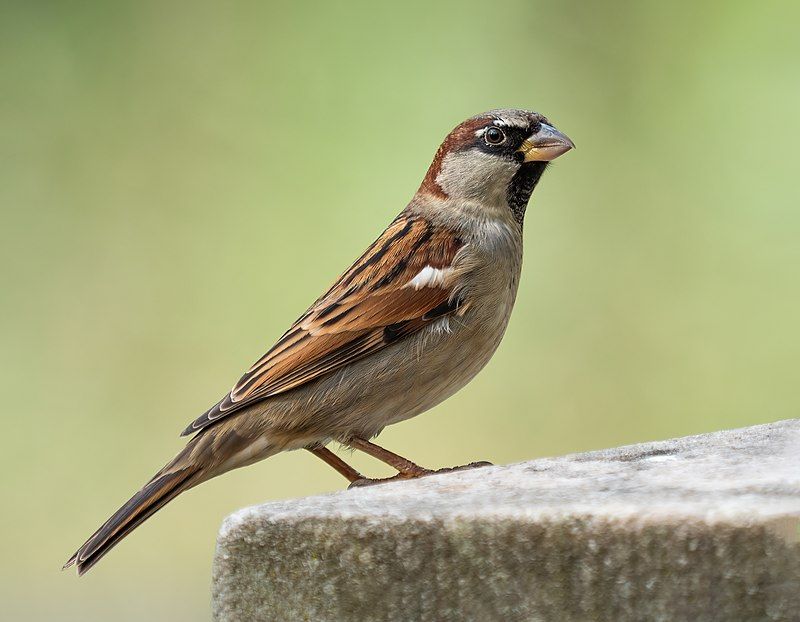
The House Sparrow, Passer domesticus, is a small, robust bird known for its adaptability to human environments. Originating from Europe and Asia, it has been introduced worldwide.
Males have a distinctive appearance with gray crowns, white cheeks, black bibs, and rufous necks, while females and young are more uniform brown and gray.
House Sparrows are opportunistic feeders, eating seeds, grains, and scraps. They often nest near buildings and other structures, making them one of the most familiar urban birds.
Despite their association with humans, their populations have declined in many regions, possibly due to changes in urban environments and competition with native species.
| Kingdom | Animalia |
| Phylum | Chordata |
| Clade | Dinosauria |
| Class | Aves |
| Order | Passeriformes |
| Family | Passeridae |
| Genus | Passer |
| Species | P. domesticus |
10. Black-Capped Chickadee (Poecile atricapillus)
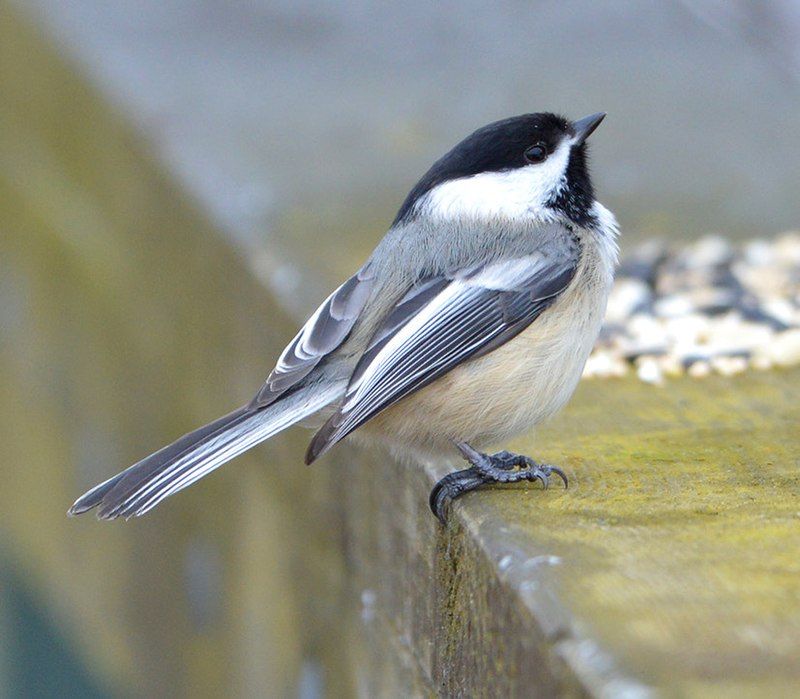
The Black-Capped Chickadee, Poecile atricapillus, is a small, charismatic bird native to North America. Recognizable by its black cap and bib, white cheeks, and grayish body, it is a favorite among bird watchers.
These birds are known for their curiosity and sociability, often approaching humans closely. Black-Capped Chickadees reside in forests, parks, and suburban areas, feeding on insects, seeds, and berries.
They are renowned for their distinctive “chick-a-dee-dee-dee” call, which varies in intensity depending on the threat level from predators. These birds are also adept at storing food and can remember thousands of hiding places.
| Kingdom | Animalia |
| Phylum | Chordata |
| Clade | Dinosauria |
| Class | Aves |
| Order | Passeriformes |
| Family | Paridae |
| Genus | Poecile |
| Species | P. atricapillus |
11. Dark-Eyed Junco (Junco hyemalis)

The Dark-Eyed Junco, Junco hyemalis, is a widespread and variable sparrow species in North America. Typically, they have a slate-gray or blackish body with a white belly, though coloration can vary significantly across regions.
These small birds are often seen foraging on the ground in forests, fields, and gardens, feeding on seeds and insects. Dark-Eyed Juncos are known for their sweet trills and “chip” calls.
They are common at bird feeders, particularly in winter, when they often form mixed-species flocks. Their presence signifies the changing seasons as they migrate to different areas based on the time of year.
| Kingdom | Animalia |
| Phylum | Chordata |
| Clade | Dinosauria |
| Class | Aves |
| Order | Passeriformes |
| Family | Passerellidae |
| Genus | Junco |
| Species | J. hyemalis |
12. Woodpeckers (Family: Picidae)
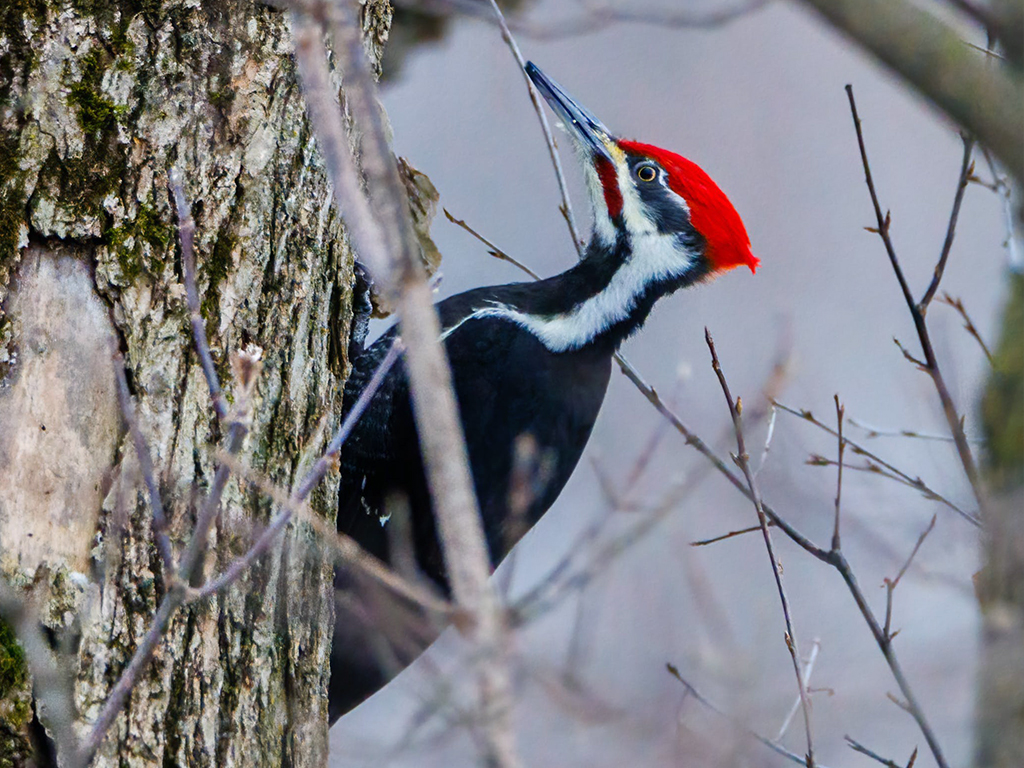
Woodpeckers, belonging to the family Picidae, encompass over 200 species worldwide, known for their unique ability to peck at wood.
They have strong beaks for drilling and drumming on trees, long sticky tongues for extracting insects, and specially adapted feet and tails for climbing and balance.
Woodpeckers vary in size and coloration but often feature striking black, white, and red patterns. They play a crucial ecological role in controlling insect populations and creating nesting cavities for other birds.
Species like the Downy Woodpecker (Dryobates pubescens) and the Pileated Woodpecker (Dryocopus pileatus) are common in North American forests, showcasing the diversity and adaptability of this bird family.
| Kingdom | Animalia |
| Phylum | Chordata |
| Clade | Dinosauria |
| Class | Aves |
| Order | Piciformes |
| Family | Picidae |
13. Blue Jay (Cyanocitta cristata)
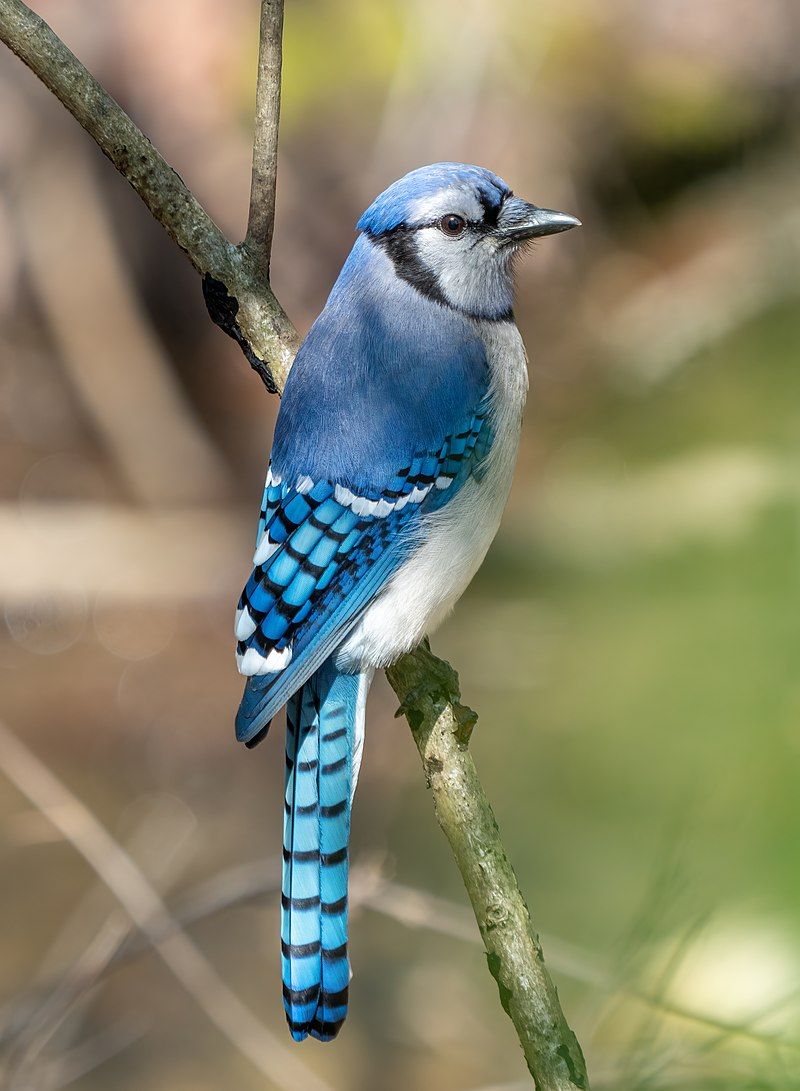
| Kingdom | Animalia |
| Phylum | Chordata |
| Clade | Dinosauria |
| Class | Aves |
| Order | Passeriformes |
| Family | Corvidae |
| Genus | Cyanocitta |
| Species | C. cristata |
14. Purple Finch (Haemorhous purpureus)
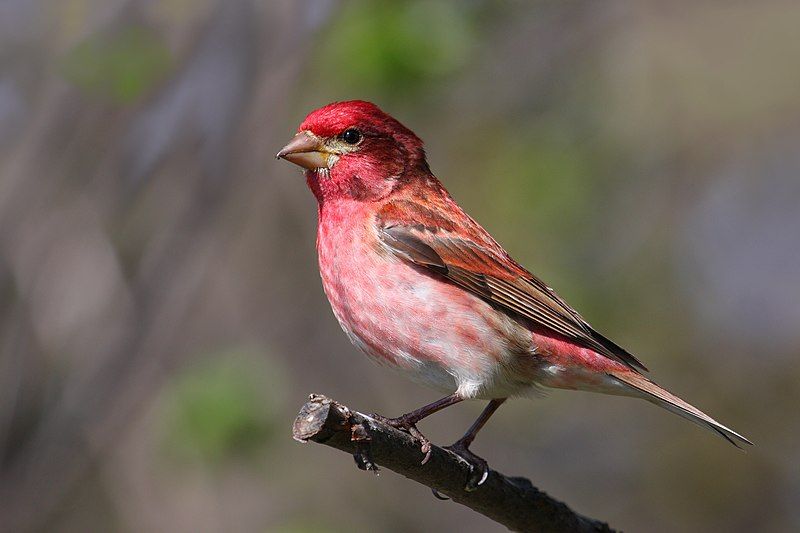
The Purple Finch, Haemorhous purpureus, is a small bird native to North America, often mistaken for the House Finch. Males display striking raspberry-red plumage on their heads, breasts, and backs, while females and juveniles are brown with bold white streaks.
These birds are slightly larger than sparrows and are known for their chunky appearance and short, conical bills. Purple Finches inhabit coniferous and mixed forests, as well as suburban areas.
They feed primarily on seeds, berries, and insects. Their song is a rich warble, similar to that of a warbler, and they are known for their melodious and complex vocalizations.
| Kingdom | Animalia |
| Phylum | Chordata |
| Clade | Dinosauria |
| Class | Aves |
| Order | Passeriformes |
| Family | Fringillidae |
| Genus | Haemorhous |
| Species | H. purpureus |
15. White-Breasted Nuthatch (Sitta carolinensis)
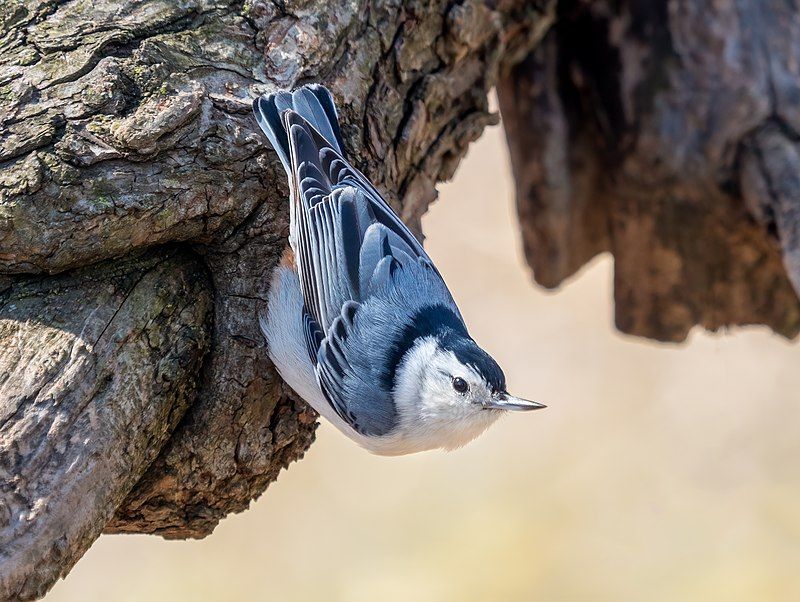
The White-Breasted Nuthatch, Sitta carolinensis, is a small, active bird commonly found in the woodlands of North America. It has a distinctive appearance with a large head, short tail, strong bill, and a black cap and nape contrasting with its white face and underparts.
The upper parts are a soft gray. These birds are known for their unique behavior of climbing down trees headfirst and foraging for insects and seeds.
They have a loud, nasal call and are often seen in pairs or small groups. White-Breasted Nuthatches are cavity nesters, often using old woodpecker holes, and they are regular visitors to bird feeders.
| Kingdom | Animalia |
| Phylum | Chordata |
| Clade | Dinosauria |
| Class | Aves |
| Order | Passeriformes |
| Family | Sittidae |
| Genus | Sitta |
| Species | S. carolinensis |
16. Red-Bellied Woodpecker (Melanerpes carolinus)
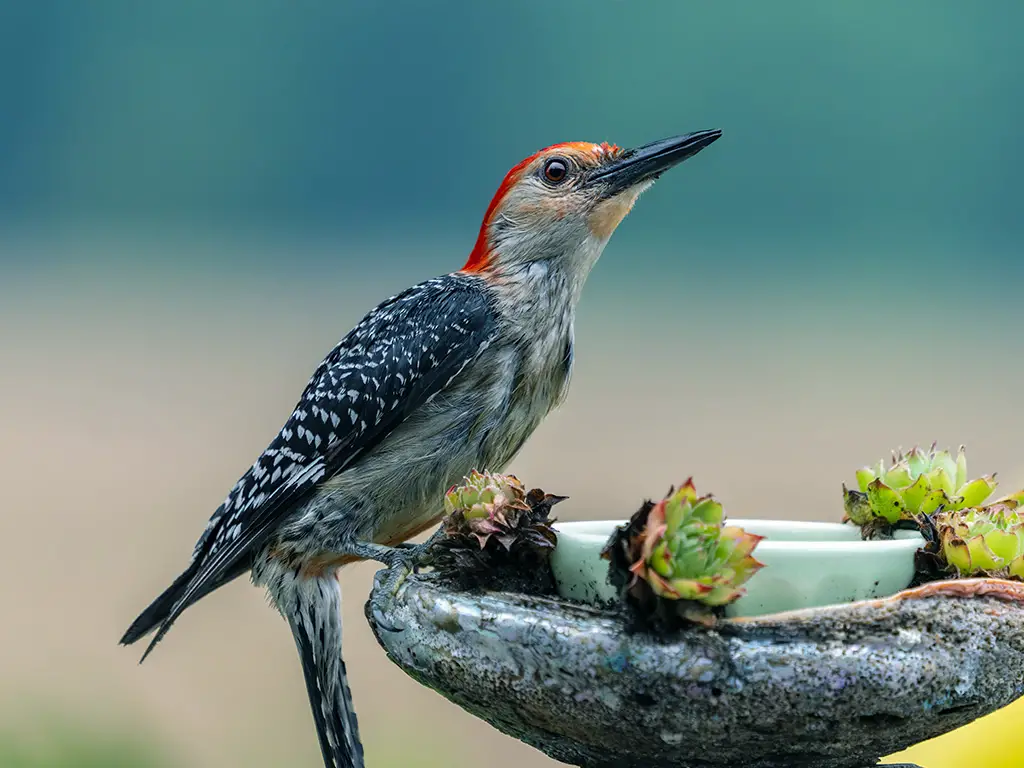
The Red-Bellied Woodpecker, Melanerpes carolinus, is a medium-sized woodpecker found throughout the eastern United States. Despite its name, its most prominent feature is the striking red cap and nape, while the belly is only faintly tinged with red.
The back is barred with black and white. These birds are adaptable and can be found in forests, woodlands, and suburban areas.
They feed on insects, fruits, and nuts, often storing food in tree crevices. Their call is a distinctive rolling “churr” sound. Red-bellied woodpeckers are known for their ability to cling to tree trunks and branches, often seen foraging for insects under the bark.
| Kingdom | Animalia |
| Phylum | Chordata |
| Clade | Dinosauria |
| Class | Aves |
| Order | Piciformes |
| Family | Picidae |
| Genus | Melanerpes |
| Species | M. carolinus |
17. American Robin (Turdus migratorius)
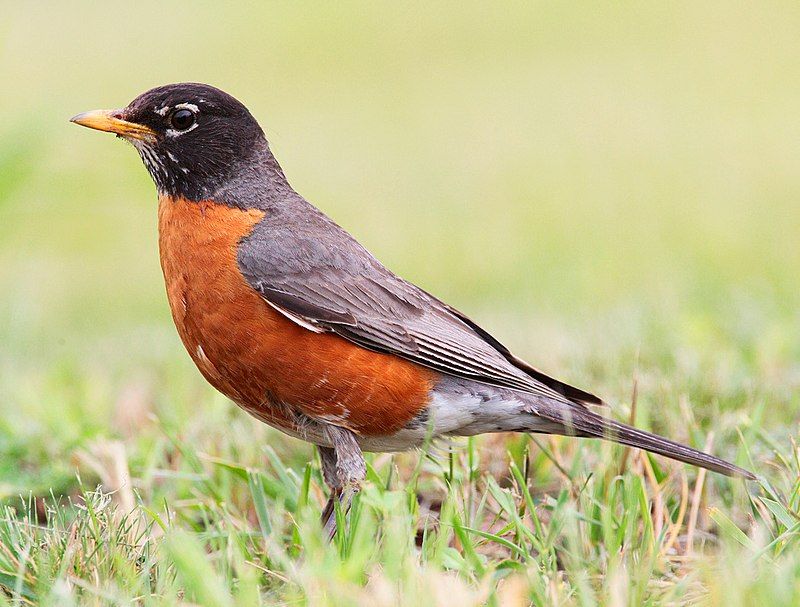
The American Robin, Turdus migratorius, is a common and widespread bird across North America. It is easily recognizable by its round body, long legs, and reddish-orange breast, contrasting with a gray back and head.
These birds often hopped across lawns, gardens, and parks, foraging for earthworms, insects, and fruit. American Robins are harbingers of spring in many areas, known for their rich, melodious song that often marks the dawn and dusk.
They build cup-shaped nests where the female lays distinctive blue eggs. American Robins are highly adaptable and thrive in urban environments despite their association with natural areas.
| Kingdom | Animalia |
| Phylum | Chordata |
| Clade | Dinosauria |
| Class | Aves |
| Order | Passeriformes |
| Family | Turdidae |
| Genus | Turdus |
| Species | T. migratorius |
18. Pileated Woodpecker (Dryocopus pileatus)
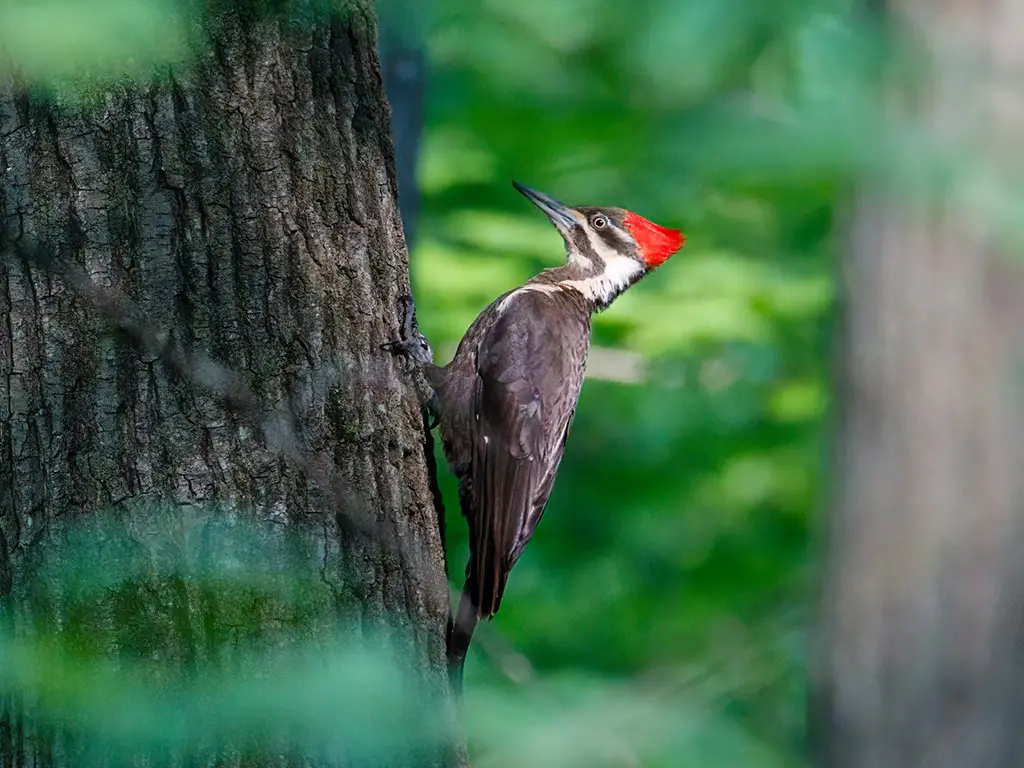
| Kingdom | Animalia |
| Phylum | Chordata |
| Clade | Dinosauria |
| Class | Aves |
| Order | Piciformes |
| Family | Picidae |
| Genus | Dryocopus |
| Species | D. pileatus |
19. American Tree Sparrow (Spizelloides arborea)
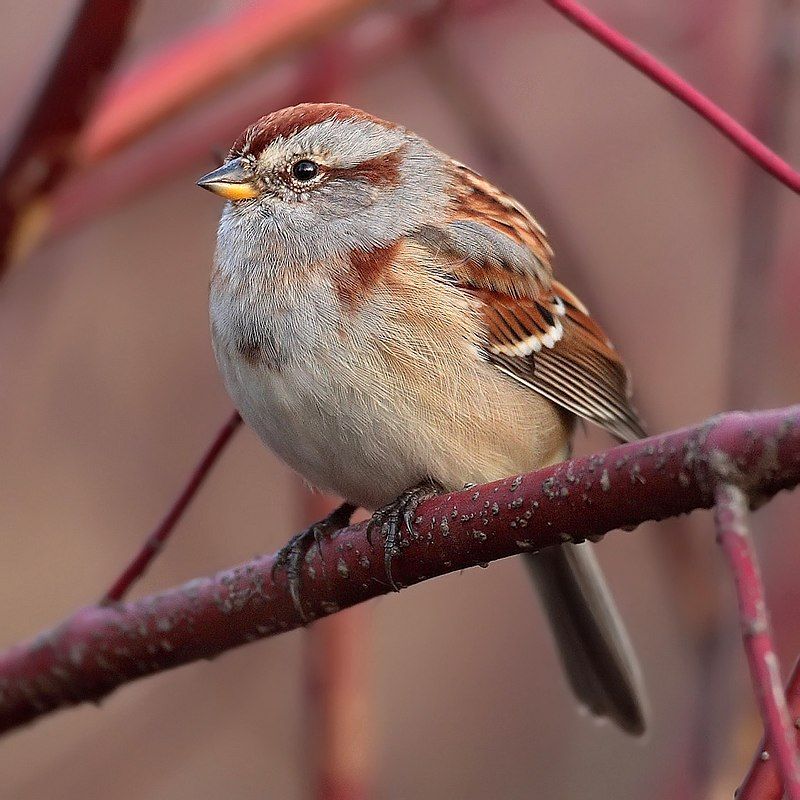
The American Tree Sparrow, scientifically named Spizelloides arborea, is a small, hardy bird of North American fields and forests. In winter, it’s often found in flocks in open, weedy areas, including gardens.
It has a round body, a long, notched tail, and a distinctive rusty cap and eye-line contrasted with a gray face. The breast displays a small dark spot. These birds feed on seeds and insects and are particularly noted for their sweet, high-pitched song and social nature.
Unlike its name suggests, the American Tree Sparrow spends more time on the ground or in shrubs than in trees, and it nests on the ground in Arctic and Subarctic regions during summer.
| Kingdom | Animalia |
| Phylum | Chordata |
| Clade | Dinosauria |
| Class | Aves |
| Order | Passeriformes |
| Family | Passerellidae |
| Genus | Spizelloides |
| Species | S. arborea |
20. Nuthatch (Family: Sittidae)
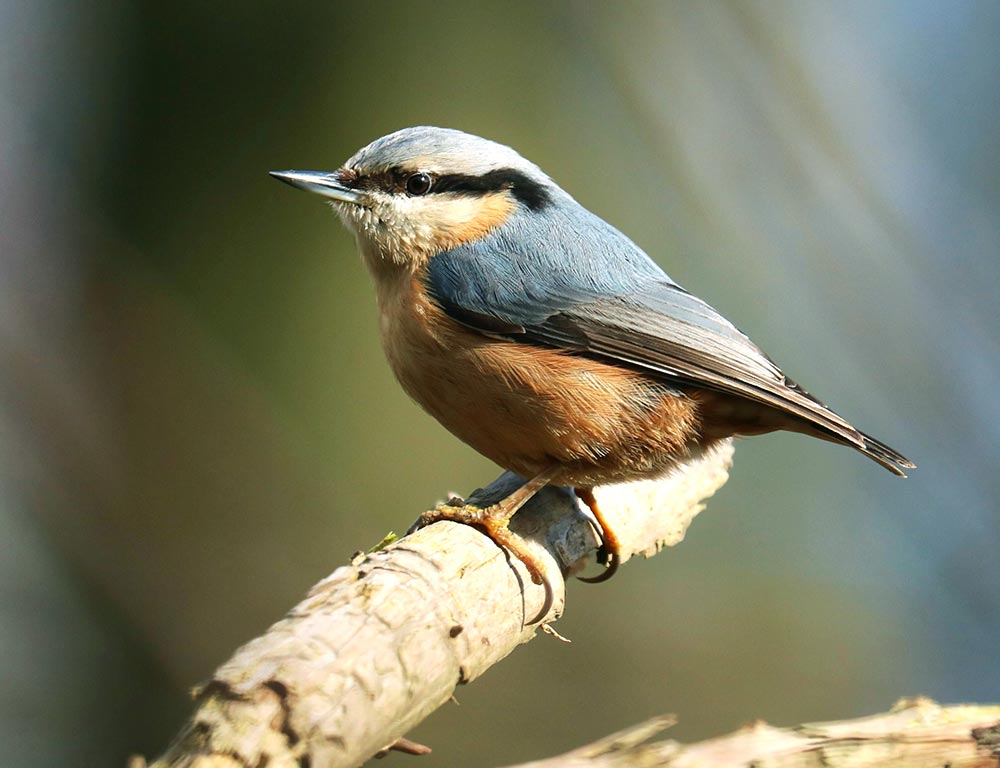
Nuthatches, belonging to the family Sittidae, are small, agile birds recognized for their ability to climb down trees headfirst. They have compact bodies, short tails, and strong bills.
The most common in North America are the White-Breasted Nuthatch (Sitta carolinensis) and the Red-Breasted Nuthatch (Sitta canadensis).
They exhibit gray or bluish upperparts and lighter underparts. Nuthatches are often heard before being seen, making various calls, including a distinctive yank-yank.
They feed on insects and seeds, often caching food for later use. Their unique climbing behavior and acrobatic feeding habits make them a delightful sight at bird feeders and in woodlands.
21. American Crow (Corvus brachyrhynchos)
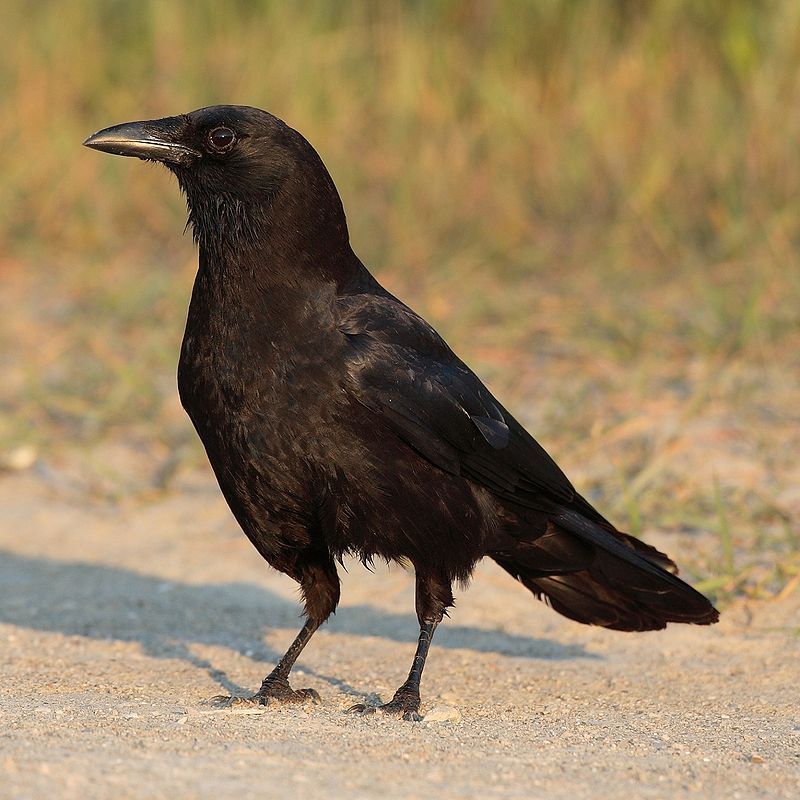
The American Crow, Corvus brachyrhynchos, is a large, intelligent, and adaptable bird found across most of North America. It has all-black plumage, a strong bill, and a fan-shaped tail. These birds are known for their problem-solving skills and complex social structures.
They thrive in varied habitats, from rural farmland to urban cities. American Crows are omnivores, eating a wide range of food, including insects, waste, and small animals.
They have a distinctive cawing call and are known to gather in large numbers in communal roosts, especially in winter.
These birds are often misunderstood but play a crucial role in ecosystem health by scavenging and controlling pest populations.
| Kingdom | Animalia |
| Phylum | Chordata |
| Clade | Dinosauria |
| Class | Aves |
| Order | Passeriformes |
| Family | Corvidae |
| Genus | Corvus |
| Species | C. brachyrhynchos |
22. Common Redpoll (Acanthis flammea)
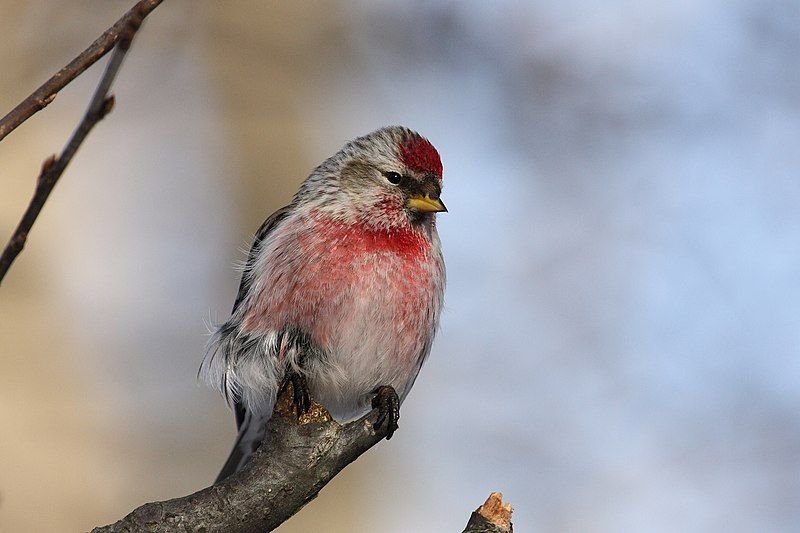
The Common Redpoll, Acanthis flammea, is a small finch of the Arctic and sub-Arctic regions, often venturing into temperate areas in winter. It has a streaked brown body, a bright red cap, and, in males, a pinkish wash on the breast.
Redpolls have a small, conical bill adapted to eating seeds, particularly from birches and alders. They are known for their resilience to cold temperatures, even burrowing into snow to stay warm.
Flocks of Common Redpolls often visit bird feeders, delighting observers with their active and social behaviors. Their flight is undulating, and their calls are a series of sharp, buzzy notes.
| Kingdom | Animalia |
| Phylum | Chordata |
| Clade | Dinosauria |
| Class | Aves |
| Order | Passeriformes |
| Family | Fringillidae |
| Genus | Acanthis |
| Species | A. flammea |
23. Common Starling (Sturnus vulgaris)
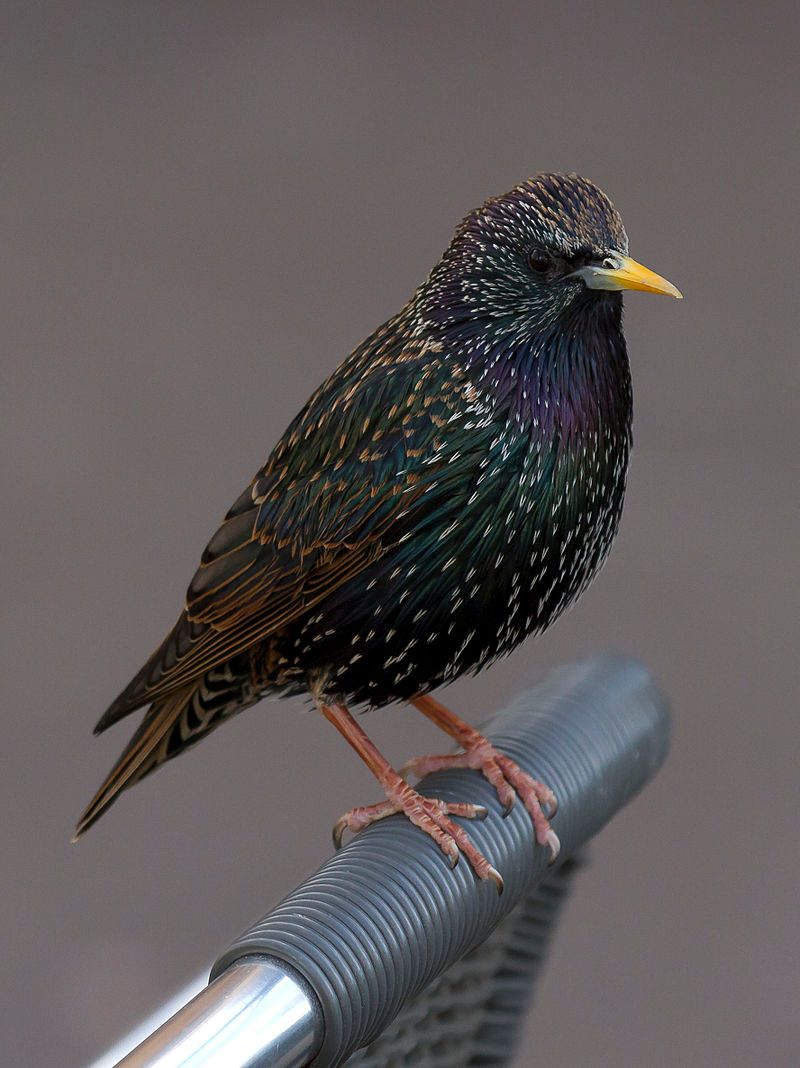
| Kingdom | Animalia |
| Phylum | Chordata |
| Clade | Dinosauria |
| Class | Aves |
| Order | Passeriformes |
| Family | Sturnidae |
| Genus | Sturnus |
| Species | S. vulgaris |
24. Mourning Dove (Zenaida macroura)
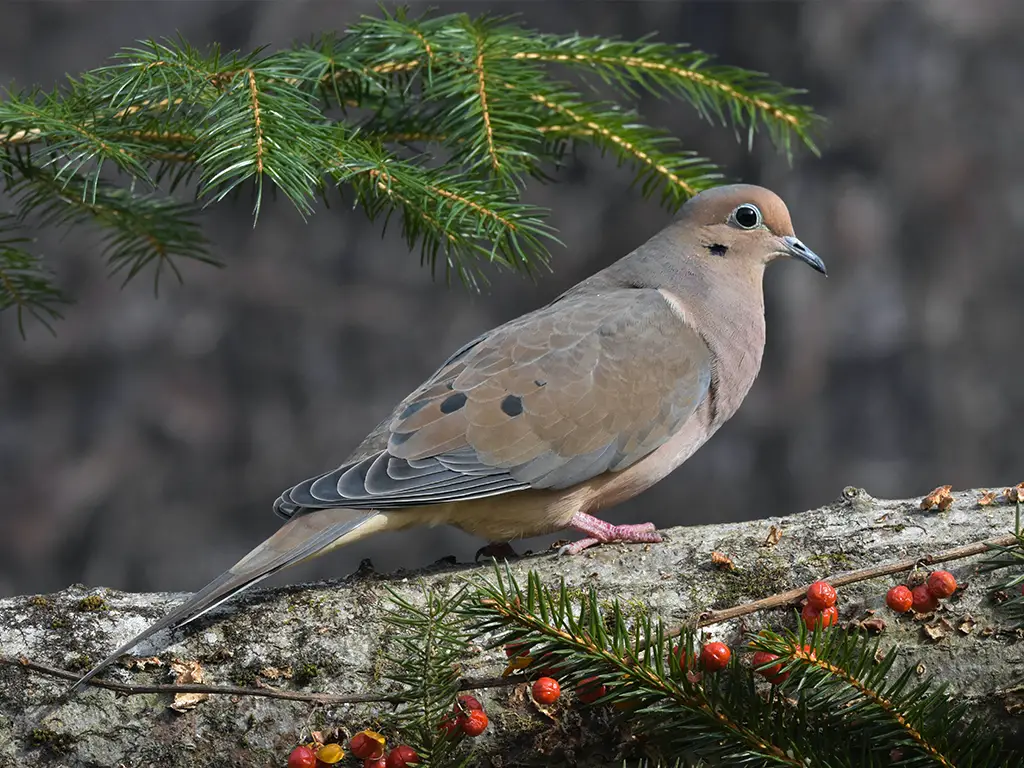
The Mourning Dove, Zenaida macroura, is a slender, graceful bird common across North America. It’s known for its soft, sorrowful cooing, which gives it its name.
The bird has a light grayish-brown body with a slightly iridescent neck, black spots on the wings, and a long, tapered tail edged white.
Mourning Doves are seen in various open and semi-open habitats, including suburban areas, farms, and grasslands. They feed primarily on seeds and are frequent visitors to bird feeders.
Despite their delicate appearance, Mourning Doves are strong fliers capable of fast, straight flight paths.
| Kingdom | Animalia |
| Phylum | Chordata |
| Clade | Dinosauria |
| Class | Aves |
| Order | Columbiformes |
| Family | Columbidae |
| Genus | Zenaida |
| Species | Z. macroura |
25. Rock Dove (Columba livia)
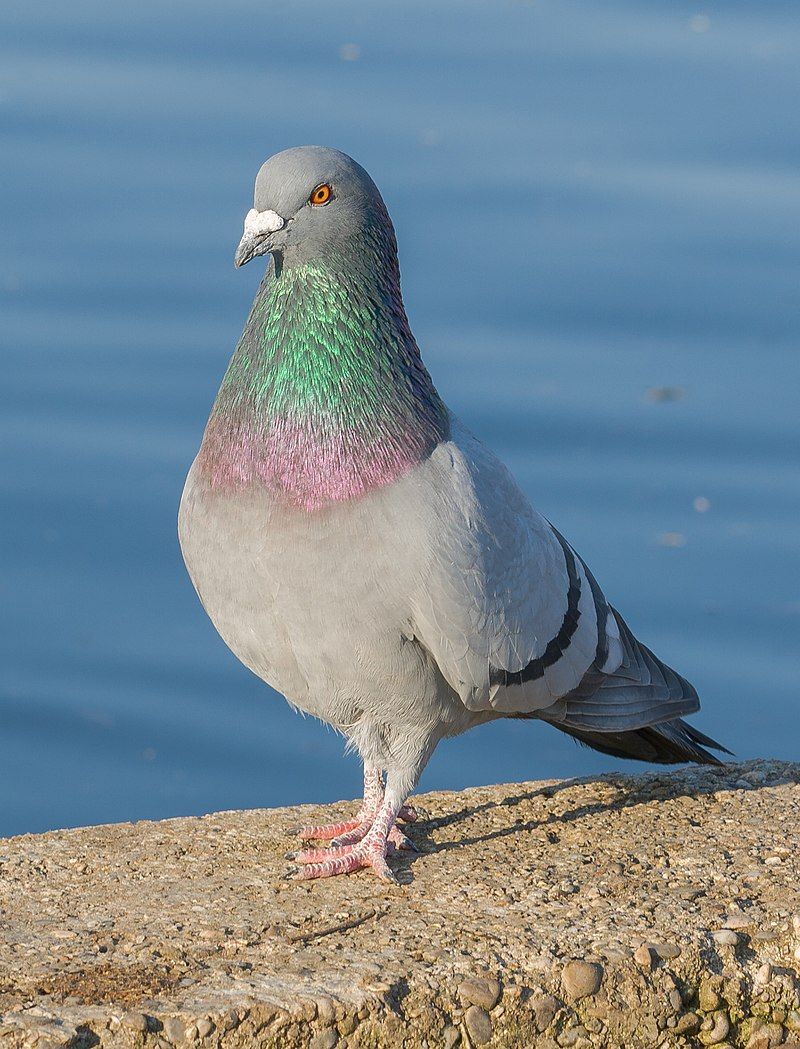
The Rock Dove, or Common Pigeon, scientifically named Columba livia, is a familiar bird in urban environments worldwide, though its origins lie in the cliffs and rock ledges of Europe, North Africa, and Western Asia.
They exhibit a variety of plumages but typically have gray bodies, iridescent neck feathers, and two black wing bars. Rock Doves are highly adaptable and often live in close association with humans, feeding on scraps, grains, and seeds.
They are known for their homing ability, making them historically significant as message carriers. Their cooing and clapping of wings are distinctive aspects of city soundscapes.
| Kingdom | Animalia |
| Phylum | Chordata |
| Clade | Dinosauria |
| Class | Aves |
| Order | Columbiformes |
| Family | Columbidae |
| Genus | Columba |
| Species | C. livia |
26. Pine Grosbeak (Pinicola enucleator)
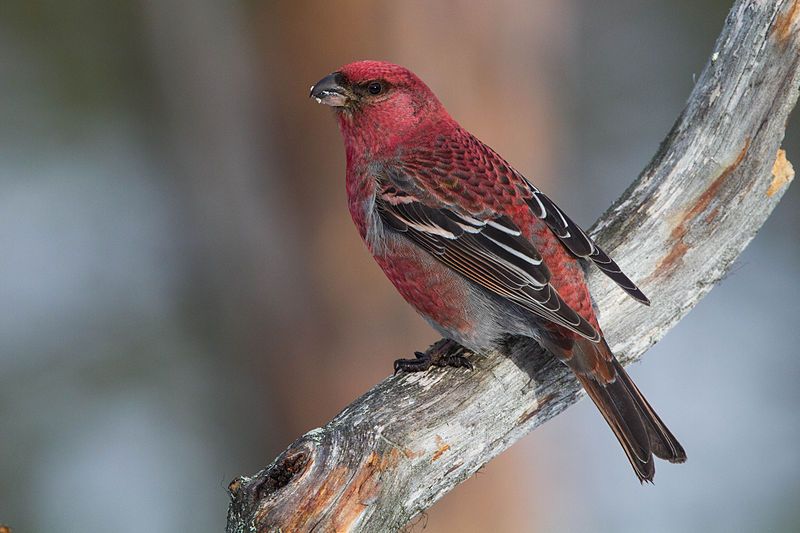
The Pine Grosbeak, Pinicola enucleator, is a large finch family member found in coniferous forests across the Northern Hemisphere.
Males are striking with their rosy-red plumage, while females and juveniles are more subdued, with grayish bodies and touches of yellow or orange.
These birds have thick, conical bills adapted for crushing seeds. Pine Grosbeaks are often seen in flocks, foraging for seeds and buds of trees and berries.
They are known for their sweet, melodious calls and songs. Despite their colorful appearance, they can be hard to spot as they tend to feed high in the treetops.
| Kingdom | Animalia |
| Phylum | Chordata |
| Clade | Dinosauria |
| Class | Aves |
| Order | Passeriformes |
| Family | Fringillidae |
| Genus | Pinicola |
| Species | P. enucleator |
27. Common Raven (Corvus corax)
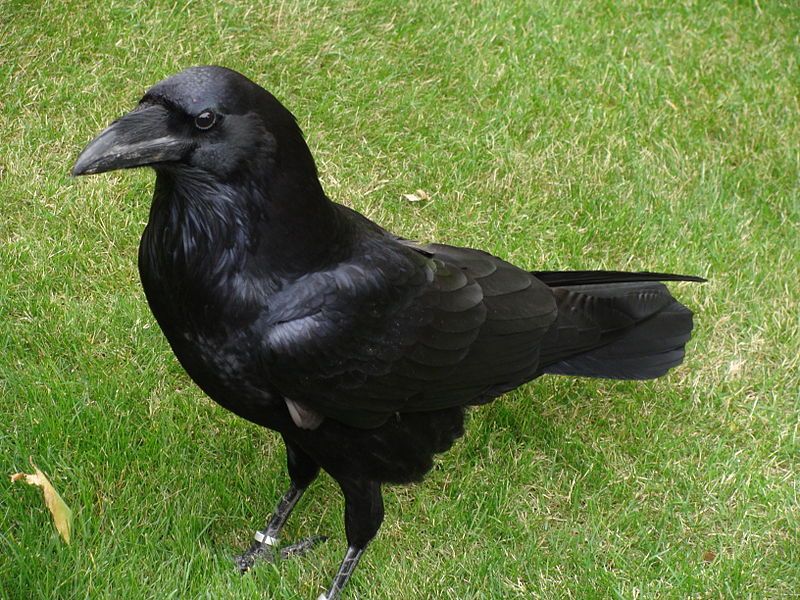
The Common Raven, Corvus corax, is one of the largest and most widespread of the corvid family. Known for its all-black plumage, large bill, and wedge-shaped tail, it symbolizes mystery in many cultures.
Ravens are highly intelligent birds, capable of complex problem-solving and social interactions. They inhabit diverse environments, from Arctic tundra to desert landscapes.
Their diet is equally varied, including insects, small animals, carrion, and garbage. Ravens are known for their deep, resonant “kroo-kroo” calls and aerial acrobatics, often seen performing rolls and somersaults in flight.
| Kingdom | Animalia |
| Phylum | Chordata |
| Clade | Dinosauria |
| Class | Aves |
| Order | Passeriformes |
| Family | Corvidae |
| Genus | Corvus |
| Species | C. corax |
28. Bald Eagle (Haliaeetus leucocephalus)
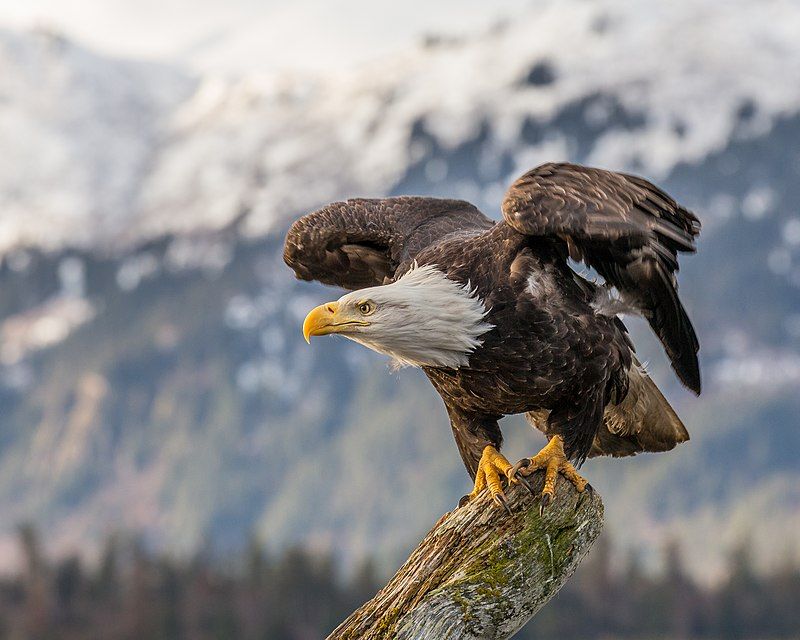
| Kingdom | Animalia |
| Phylum | Chordata |
| Clade | Dinosauria |
| Class | Aves |
| Order | Accipitriformes |
| Family | Accipitridae |
| Genus | Haliaeetus |
| Species | H. leucocephalus |
29. Waxwing Birds (Family: Bombycillidae)
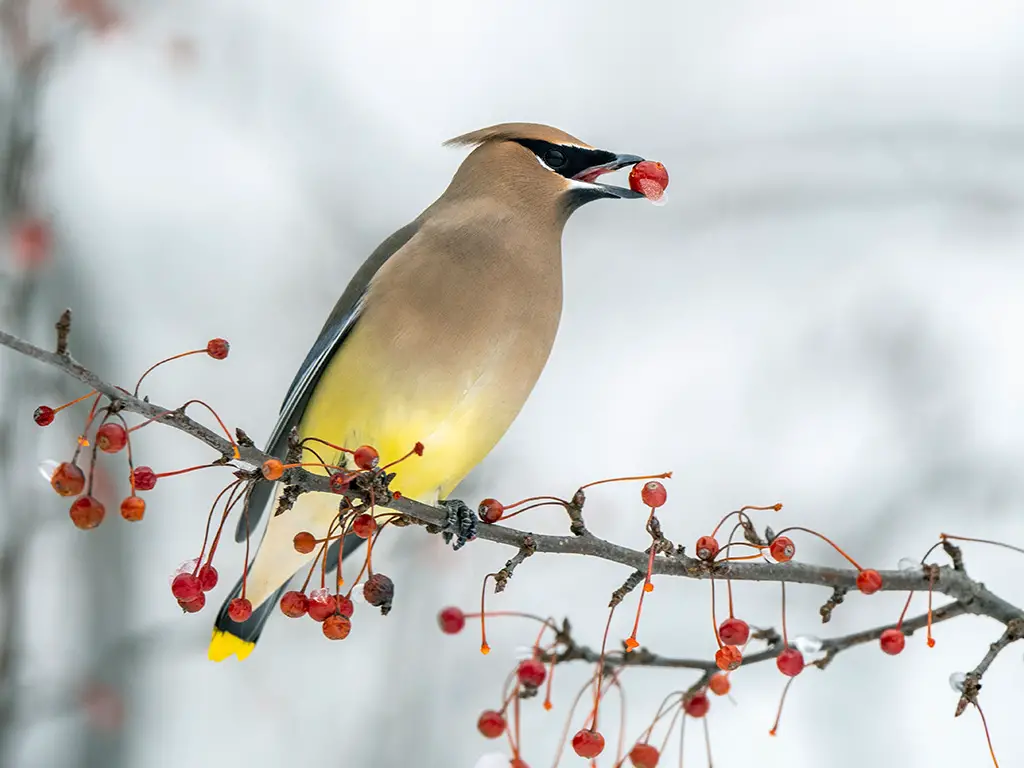
Waxwing birds, belonging to the family Bombycillidae, are characterized by their sleek, silky plumage and unique waxy red tips on their wing feathers.
The most common species in North America are the Cedar Waxwing (Bombycilla cedrorum) and the Bohemian Waxwing (Bombycilla garrulus).
These medium-sized birds have a crest on their heads, black masks around their eyes, and a general palette of brown, gray, and yellow.
Waxwings are social birds, often seen in large flocks, particularly in berry-laden trees. They primarily feed on fruit but also consume insects during breeding season.
Their calls are high-pitched, trilling notes. Waxwings are known for their nomadic lifestyle, wandering in search of food sources.
30. Osprey (Pandion haliaetus)

The Osprey, Pandion haliaetus, is a large, distinctive bird of prey specializing in fish hunting. It is found near coastlines, rivers, and lakes across the world.
The Osprey has a white underbelly, dark brown upperparts, and a characteristic white head with a dark eye stripe. It possesses long, narrow wings and sharp talons with reversible outer toes, perfect for grasping slippery fish.
Ospreys are unique among North American raptors because their diet is exclusively of fish. They often hover over the water before diving feet first to catch their prey.
These birds are known for their spectacular nests, often built on top of poles, trees, or other high structures.
| Kingdom | Animalia |
| Phylum | Chordata |
| Clade | Dinosauria |
| Class | Aves |
| Order | Accipitriformes |
| Family | Pandionidae |
| Genus | Pandion |
| Species | P. haliaetus |
31. Peregrine Falcon (Falco peregrinus)
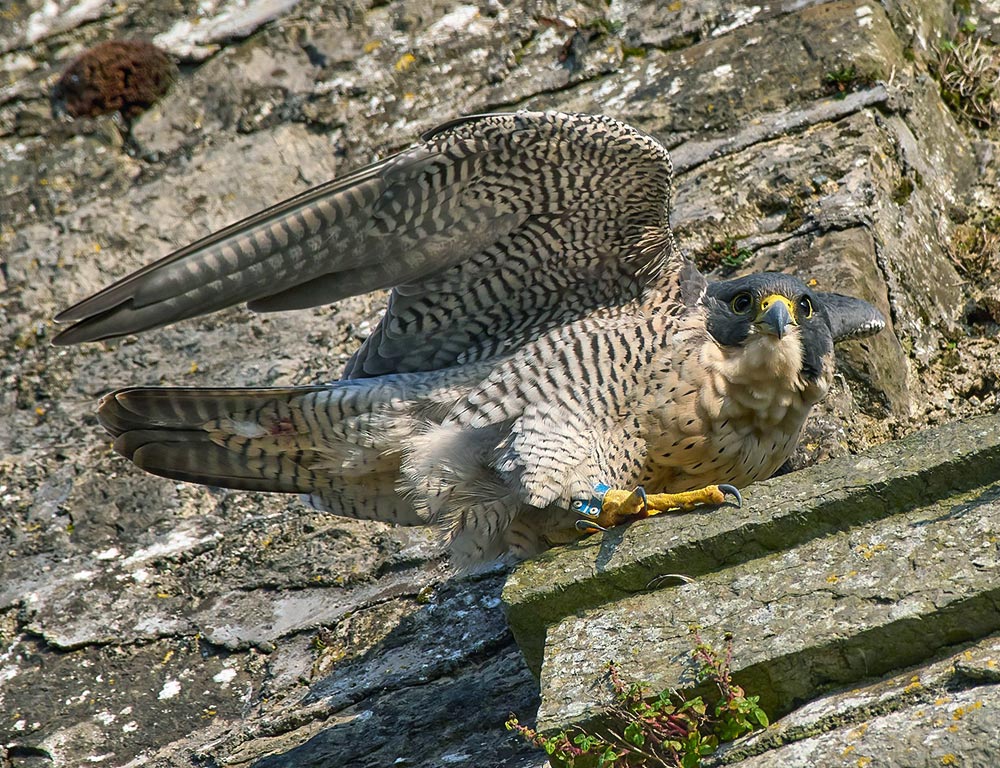
The Peregrine Falcon, Falco peregrinus, is a renowned bird of prey, famous for being the fastest animal on earth, reaching speeds over 200 mph during its hunting stoop.
It has a blue-gray back, barred white underparts, and a distinctive black “mustache” contrasting with its white face. Peregrine Falcons are found worldwide and adapt to various habitats, including urban cities, where they nest on tall buildings.
Their diet primarily consists of birds, which they capture in mid-air. Peregrine Falcons have made a remarkable recovery from the brink of extinction thanks to conservation efforts addressing the impact of pesticides like DDT.
| Kingdom | Animalia |
| Phylum | Chordata |
| Clade | Dinosauria |
| Class | Aves |
| Order | Falconiformes |
| Family | Falconidae |
| Genus | Falco |
| Species | F. peregrinus |
32. Red Crossbill (Loxia curvirostra)
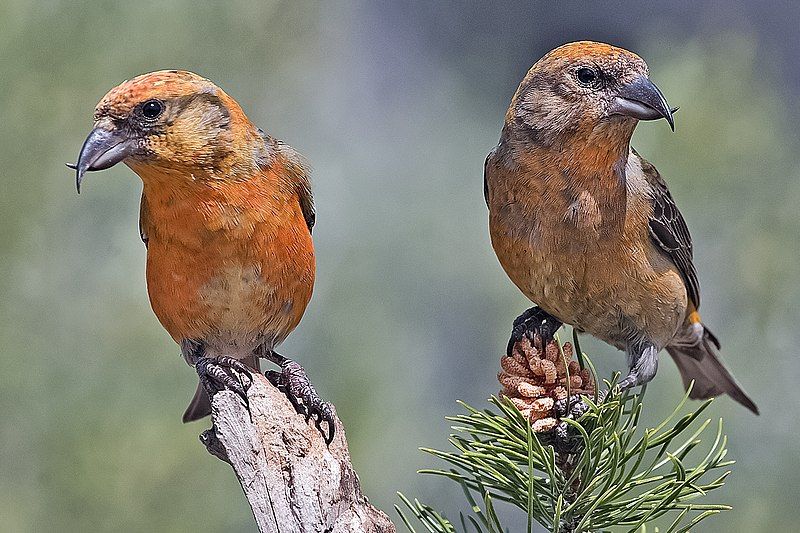
The Red Crossbill, Loxia curvirostra, is a small, distinctive finch known for its unusual crossed bill. The male typically has bright red plumage, while the female is more olive-yellow.
This unique bill adaptation allows them to extract seeds from conifer cones, their main food source. Red Crossbills are found in coniferous forests throughout the Northern Hemisphere.
They are nomadic, moving around in search of cone crops. Their calls are a series of sharp, metallic chips.
Interestingly, the shape of their bills varies among populations, adapted to different species of conifers, illustrating a fascinating example of evolutionary specialization.
| Kingdom | Animalia |
| Phylum | Chordata |
| Clade | Dinosauria |
| Class | Aves |
| Order | Passeriformes |
| Family | Fringillidae |
| Genus | Loxia |
| Species | L. curvirostra |
33. Evening Grosbeak (Hesperiphona vespertina)
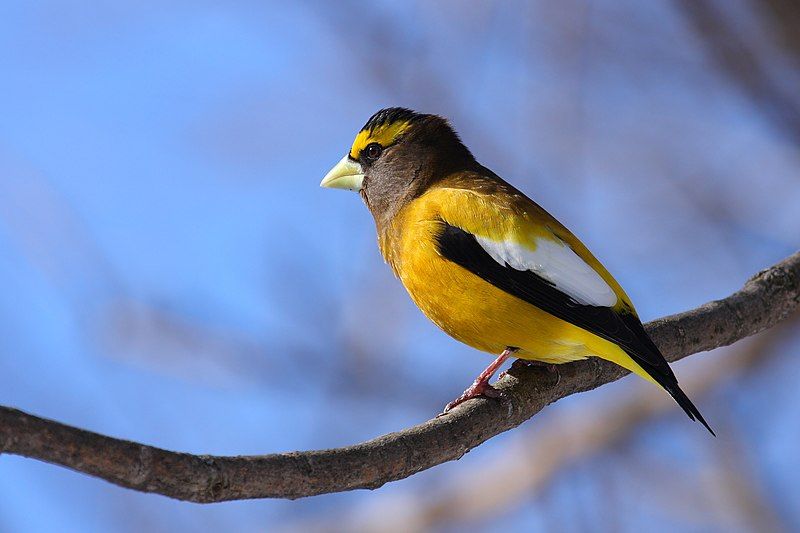
| Kingdom | Animalia |
| Phylum | Chordata |
| Clade | Dinosauria |
| Class | Aves |
| Order | Passeriformes |
| Family | Fringillidae |
| Genus | Hesperiphona |
| Species | H. vespertina |
34. Barred Owl (Strix varia)
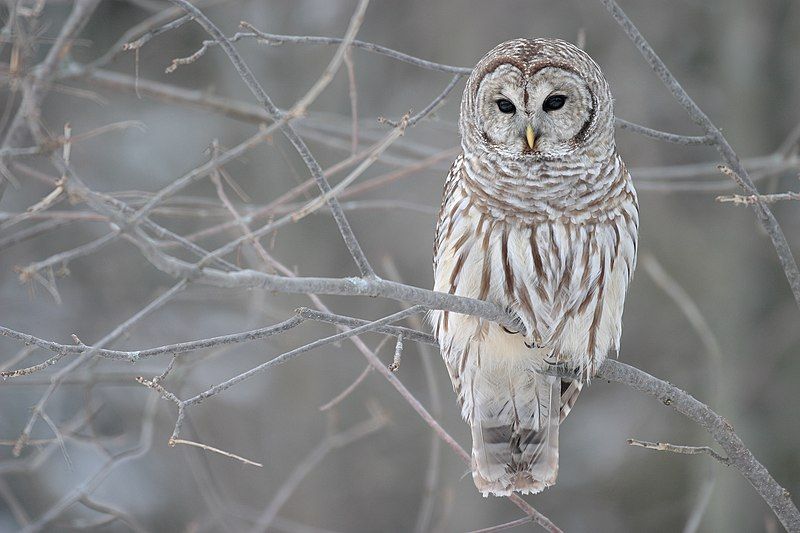
The Barred Owl, Strix varia, is a large North American owl known for its distinctive “Who cooks for you?” call. It has a rounded head without ear tufts, deep brown eyes, and a gray-brown plumage barred with white horizontal stripes on the body and vertical stripes on the chest.
Barred Owls prefer mature forests with large trees for nesting and are often found near water. They are opportunistic predators, hunting a variety of small animals at night.
These owls are known for their haunting calls that echo through the forests. Unlike many other owl species, Barred Owls have been known to be quite vocal during the day and at night.
| Kingdom | Animalia |
| Phylum | Chordata |
| Clade | Dinosauria |
| Class | Aves |
| Order | Strigiformes |
| Family | Strigidae |
| Genus | Strix |
| Species | S. varia |
35. Ruby-Crowned Kinglet (Regulus calendula)
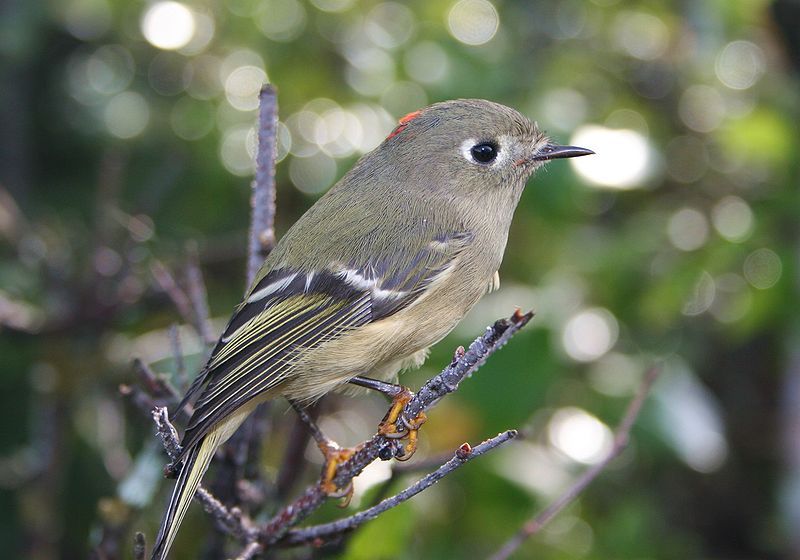
The Ruby-Crowned Kinglet, Regulus calendula, is a tiny, energetic bird common across North America. Despite its name, the ruby crown is often not visible; males display the bright red patch on top of their heads only when excited or agitated.
These birds have olive-green plumage, a prominent white eye-ring, and a small, pointed bill. They are constantly in motion, flitting through trees and shrubs for insects.
Ruby-Crowned Kinglets are known for their complex and melodious song, a surprising feat given their small size. They inhabit coniferous forests and mixed woodlands, often migrating long distances between summer and winter habitats.
| Kingdom | Animalia |
| Phylum | Chordata |
| Clade | Dinosauria |
| Class | Aves |
| Order | Passeriformes |
| Family | Regulidae |
| Genus | Corthylio |
| Species | C. calendula |
36. Ruby-Throated Hummingbird (Archilochus colubris)
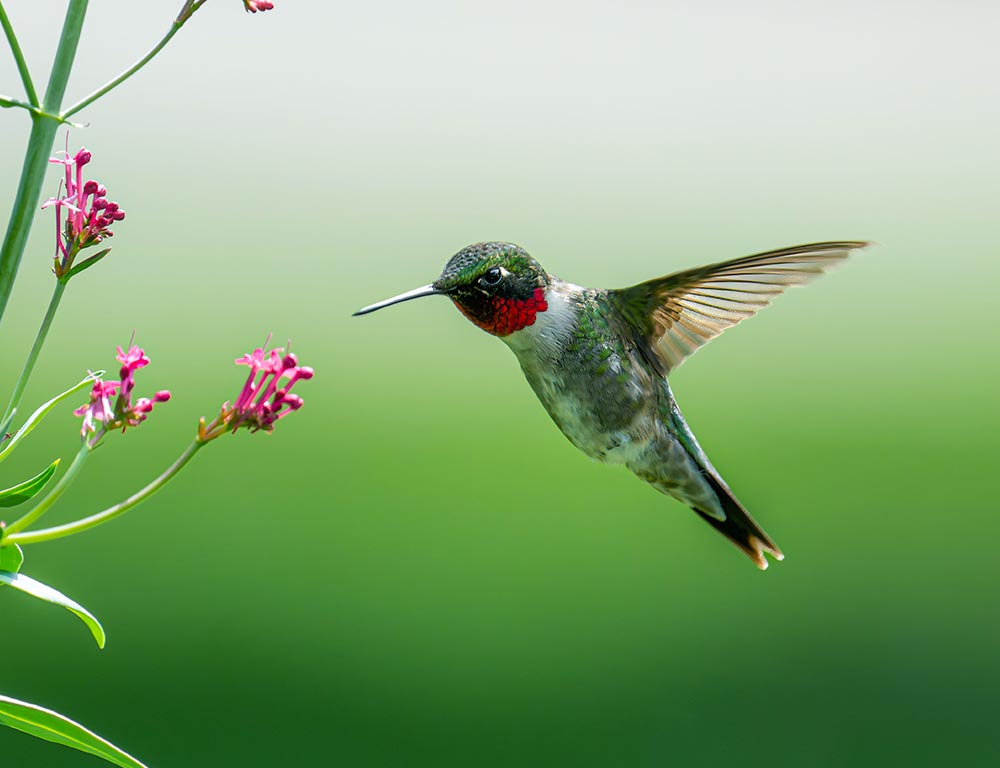
The Ruby-Throated Hummingbird, Archilochus colubris, is the most widespread hummingbird in North America. Males are known for their iridescent ruby-red throat and metallic green upperparts.
Females lack the ruby throat and are more subdued with white underparts and greenish upperparts. These tiny birds are incredible fliers, able to hover in place and even fly backward.
They feed primarily on nectar from flowers, using their long, slender beaks and rapid wingbeats to hover near blooms. They also consume small insects for protein.
Ruby-throated hummingbirds are migratory, traveling impressive distances between their breeding grounds in North America and wintering areas in Central America.
| Kingdom | Animalia |
| Phylum | Chordata |
| Clade | Strisores |
| Class | Aves |
| Order | Apodiformes |
| Family | Trochilidae |
| Genus | Archilochus |
| Species | A. colubris |
37. Snowy Owl (Bubo scandiacus)
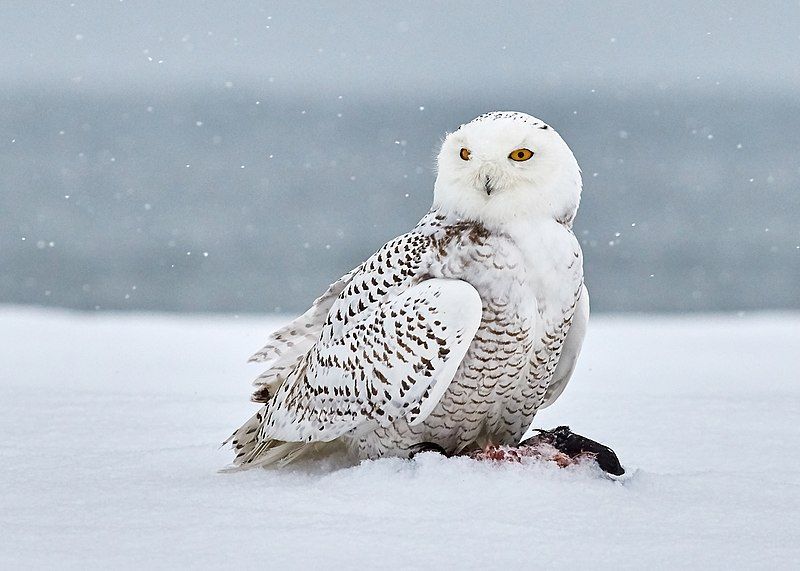
The Snowy Owl, Bubo scandiacus, is a stunning bird of prey known for its striking white plumage, which provides excellent camouflage in Arctic habitats. These large owls have rounded heads, yellow eyes, and black beaks.
Males are almost pure white, while females and young birds have darker skin. Snowy Owls are primarily found in the Arctic tundra but can migrate south during the winter.
They are diurnal, hunting both day and night, preying mainly on small mammals like lemmings. The Snowy Owl’s ability to live in extremely cold temperatures and its nomadic nature, following prey availability, make it a fascinating species among birds of prey.
| Kingdom | Animalia |
| Phylum | Chordata |
| Clade | Dinosauria |
| Class | Aves |
| Order | Strigiformes |
| Family | Strigidae |
| Genus | Bubo |
| Species | B. scandiacus |
38. Brown Creeper (Certhia americana)
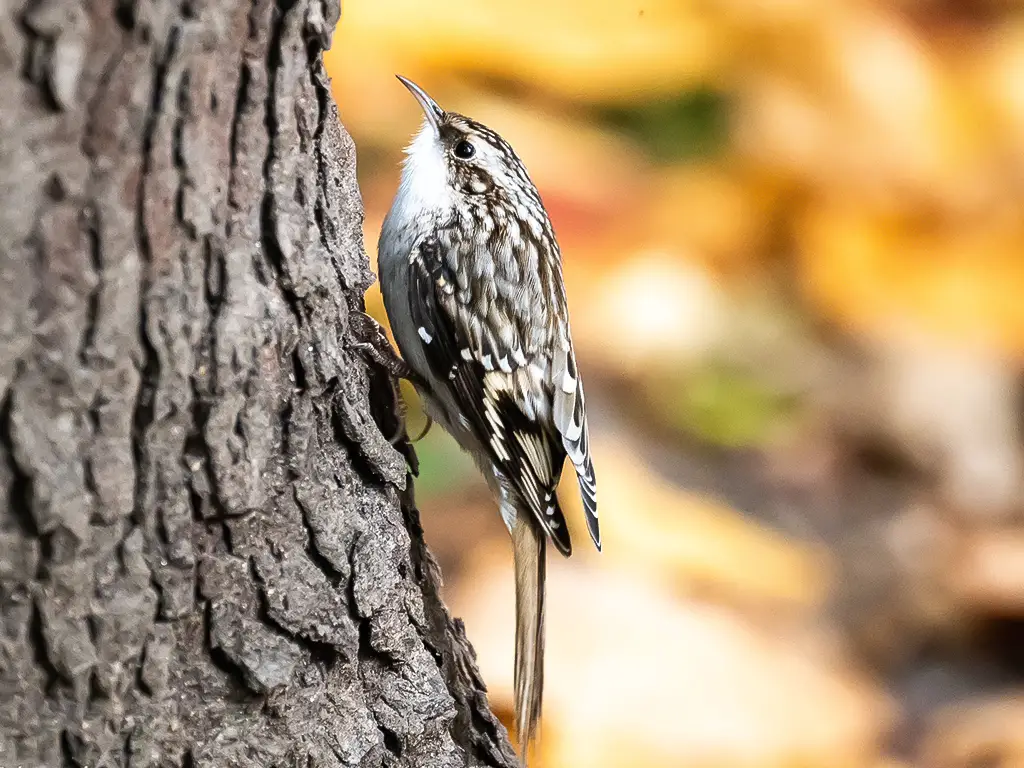
| Kingdom | Animalia |
| Phylum | Chordata |
| Clade | Dinosauria |
| Class | Aves |
| Order | Passeriformes |
| Family | Certhiidae |
| Genus | Certhia |
| Species | C. americana |
39. Great Grey Owl (Strix nebulosa)
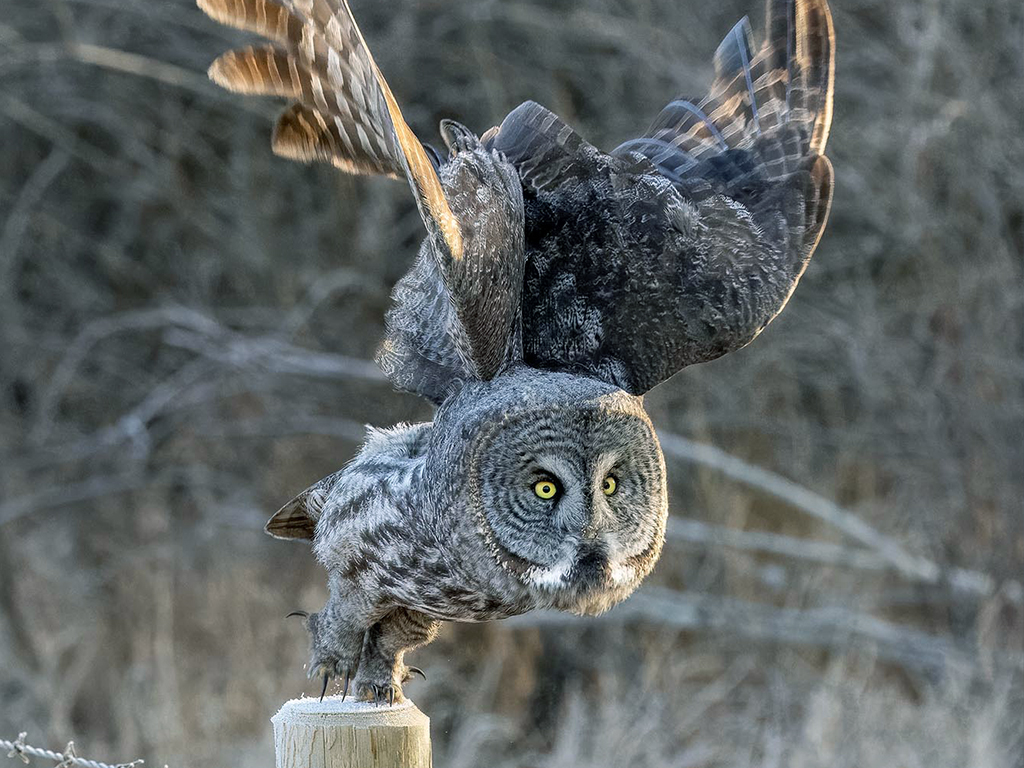
The Great Grey Owl, Strix nebulosa, is one of the largest owl species, renowned for its impressive size and distinctive facial features. It has a large, rounded head with no ear tufts and a gray face surrounded by a ring of darker feathers.
Despite its size, its actual body is smaller than it appears, as its feathers are very fluffy and thick. The plumage is silvery-gray with fine white and dark streaks, allowing for excellent camouflage against tree bark.
Great Grey Owls inhabit boreal forests across the Northern Hemisphere, where they silently hunt for small rodents, often plunging into the snow to catch prey. Their haunting calls contribute to the mystique of the northern wilderness.
| Kingdom | Animalia |
| Phylum | Chordata |
| Clade | Dinosauria |
| Class | Aves |
| Order | Strigiformes |
| Family | Strigidae |
| Genus | Strix |
| Species | S. nebulosa |
40. Spruce Grouse (Falcipennis canadensis)
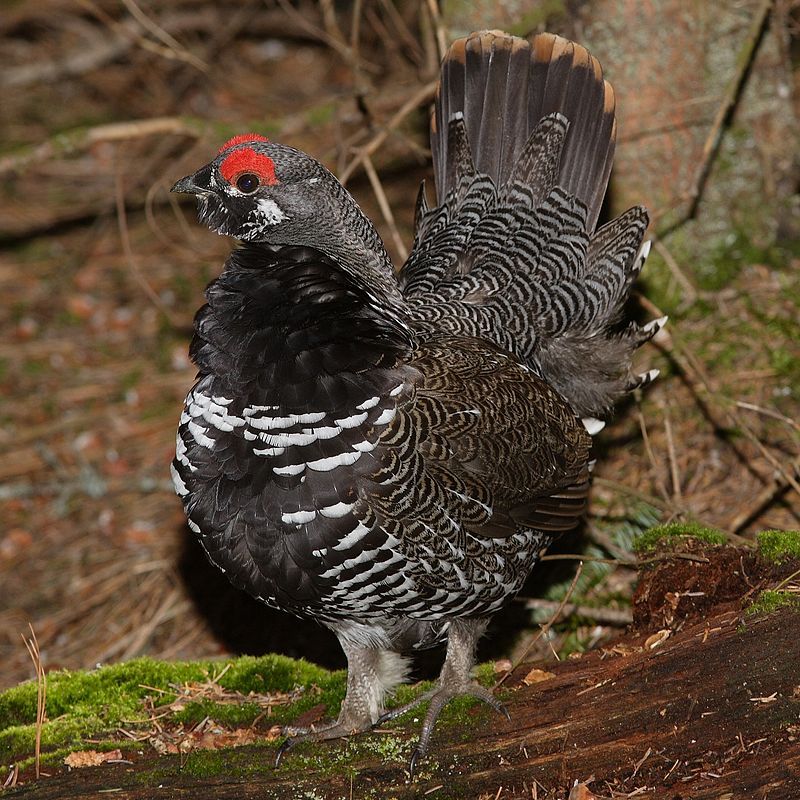
The Spruce Grouse, Falcipennis canadensis, is a medium-sized bird found in the coniferous forests of North America. Known for its subtle but beautiful plumage, the male has a black throat and breast, grayish-brown upperparts with black spots, and a distinctive red eyebrow.
Females are mottled brown, providing excellent camouflage. Spruce Grouse are known for their unflappable nature, often allowing humans to approach closely.
They feed primarily on conifer needles, buds, and berries. This diet gives them a distinct resinous smell, earning them the nickname “fool’s hen” due to their approachable behavior and their diet’s influence on their taste.
| Kingdom | Animalia |
| Phylum | Chordata |
| Clade | Dinosauria |
| Class | Aves |
| Order | Galliformes |
| Family | Phasianidae |
| Genus | Canachites |
| Species | C. canadensis |
41. Wrens (Family: Troglodytidae)
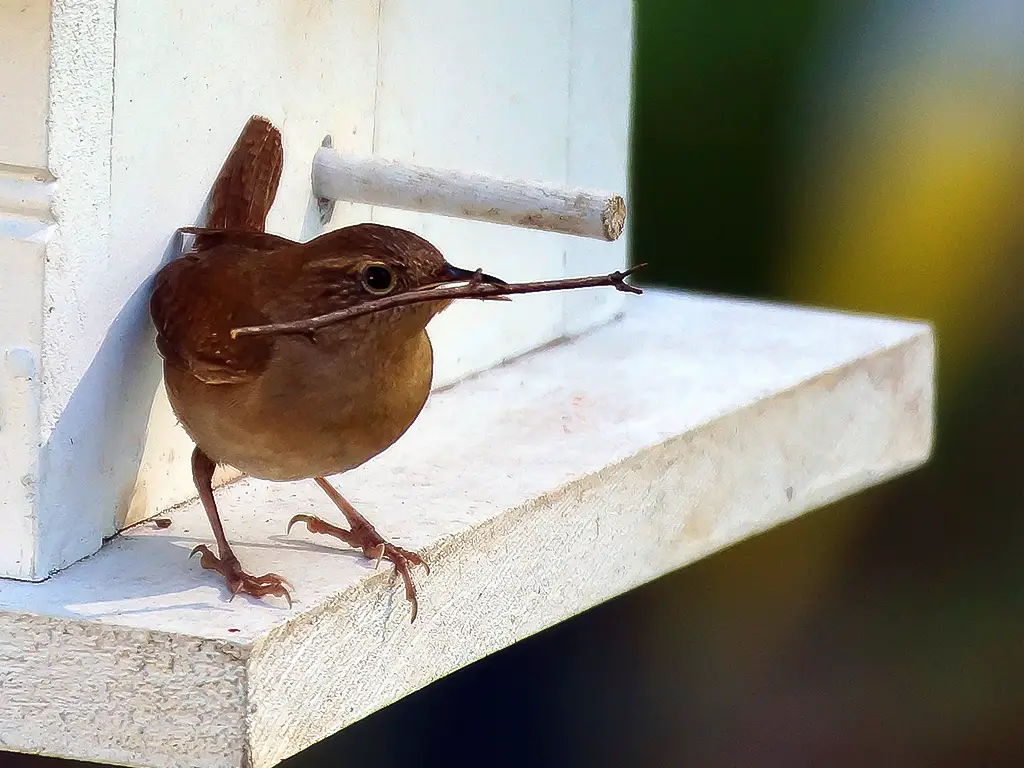
Wrens, belonging to the family Troglodytidae, are small, active birds known for their loud and complex songs. They typically have brownish plumage, often with patterns of spots or bars, and a distinctive upright tail.
The Carolina Wren (Thryothorus ludovicianus) and the House Wren (Troglodytes aedon) are common species in North America. These birds are often found in dense vegetation or wooded areas, where they actively forage for insects and spiders.
Wrens are known for their energetic behavior and can be quite bold, often investigating human-made structures for potential nesting sites. Their nests are often dome-shaped, with a small entrance hole.
| Kingdom | Animalia |
| Phylum | Chordata |
| Clade | Dinosauria |
| Class | Aves |
| Order | Passeriformes |
| Family | Troglodytidae |
42. Eastern Screech Owl (Megascops asio)
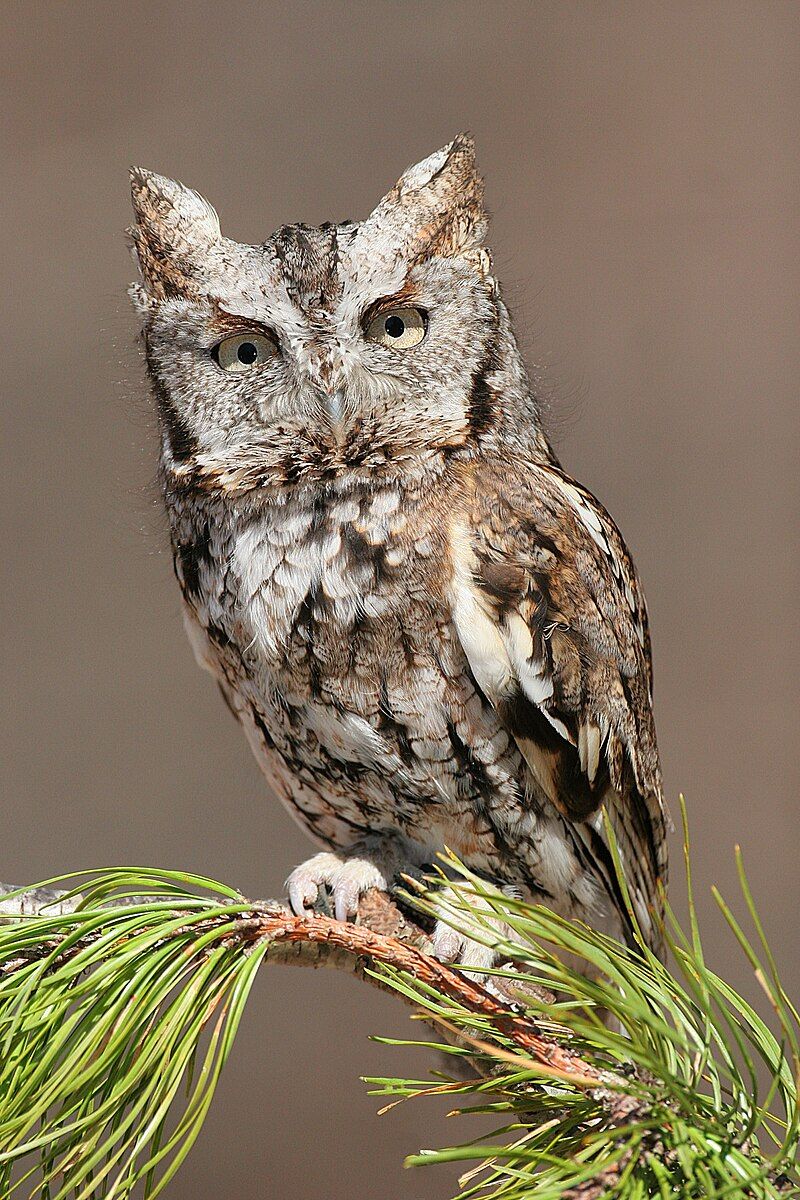
The Eastern Screech Owl, Megascops asio, is a small owl common in Eastern North America. It comes in two color morphs: a gray phase and a red (rufous) phase, both providing excellent camouflage against tree bark.
This owl has a stocky body, a large head with ear tufts, and yellow eyes. It inhabits a variety of woodland habitats, as well as suburban areas with mature trees.
The Eastern Screech Owl feeds on various small animals, including insects, rodents, and small birds. Its call is a haunting trill or soft, mournful whinny, often heard at night.
Despite their nocturnal nature, these owls are sometimes spotted during the day, roosting in tree cavities.
| Kingdom | Animalia |
| Phylum | Chordata |
| Clade | Dinosauria |
| Class | Aves |
| Order | Strigiformes |
| Family | Strigidae |
| Genus | Megascops |
| Species | M. asio |
43. Cooper’s Hawk (Accipiter cooperii)
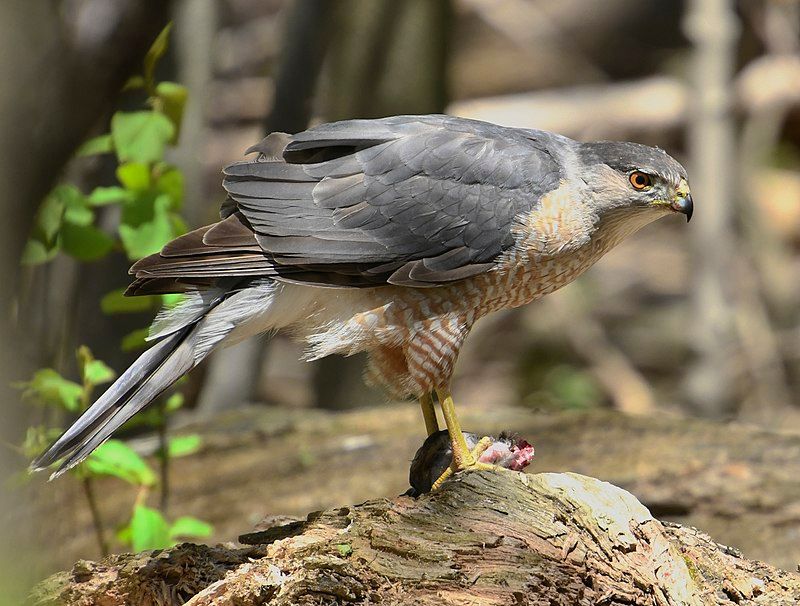
| Kingdom | Animalia |
| Phylum | Chordata |
| Clade | Dinosauria |
| Class | Aves |
| Order | Accipitriformes |
| Family | Accipitridae |
| Genus | Accipiter |
| Species | A. cooperii |
44. Two-Barred Crossbill (Loxia leucoptera)
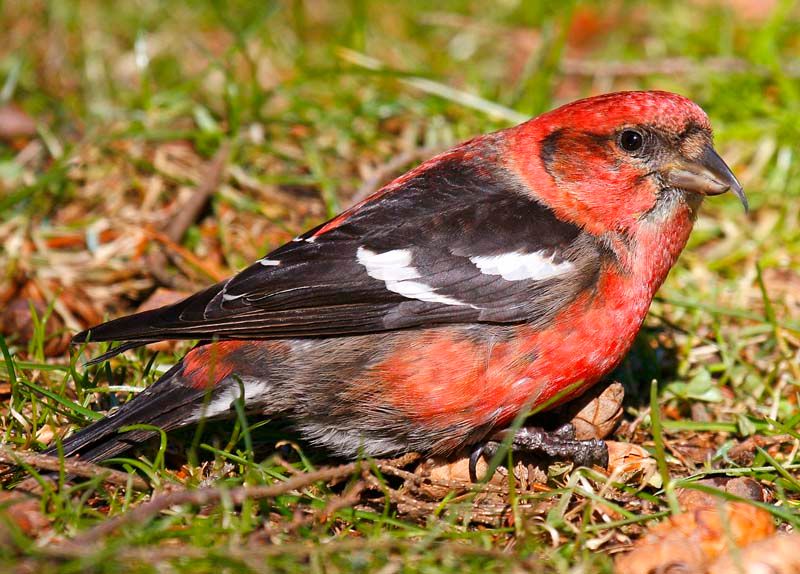
The Two-Barred Crossbill, Loxia leucoptera, also known as the White-Winged Crossbill, is a small, distinctive bird found in the boreal forests of North America and Eurasia.
It is characterized by its crossed mandibles, which are adapted to extract seeds from conifer cones, primarily spruces and larches. Males are typically pink-red with two bold white wing bars, while females are more yellowish-green with the same wing markings.
These birds are nomadic, moving in large flocks for cone crops. Their calls are a series of sharp, chattering notes. The Two-Barred Crossbill’s unique bill and its specialized feeding behavior are excellent examples of evolutionary adaptation.
| Kingdom | Animalia |
| Phylum | Chordata |
| Clade | Dinosauria |
| Class | Aves |
| Order | Passeriformes |
| Family | Fringillidae |
| Genus | Loxia |
| Species | L. leucoptera |
45. Red-Winged Blackbird (Agelaius phoeniceus)
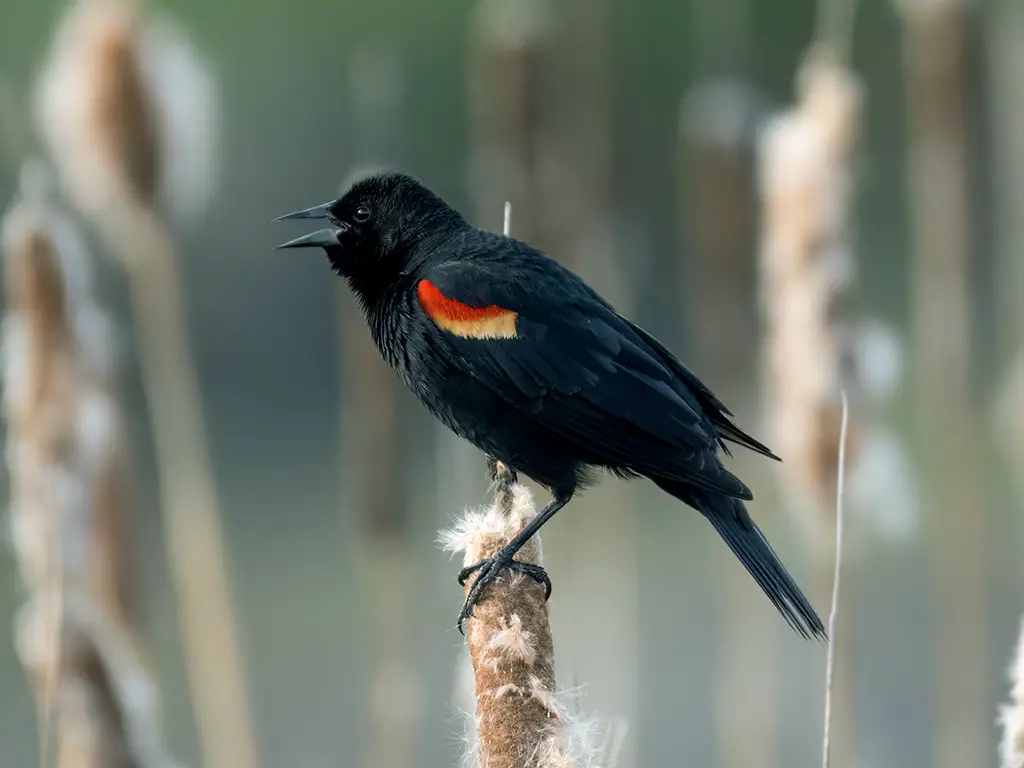
The Red-Winged Blackbird, Agelaius phoeniceus, is one of North America’s most common and widespread birds. The male is easily recognizable with its glossy black plumage and striking red-and-yellow shoulder patches.
Females are more subdued, with streaky brown plumage resembling a large sparrow. These birds are often found in wetlands, marshes, and open fields, where they feed on seeds and insects.
The male’s distinctive conk-la-ree! Song and territorial behavior during the breeding season are notable. Red-winged blackbirds are social birds, often seen in large flocks, especially during migration and in winter roosts.
| Kingdom | Animalia |
| Phylum | Chordata |
| Clade | Dinosauria |
| Class | Aves |
| Order | Passeriformes |
| Family | Icteridae |
| Genus | Agelaius |
| Species | A. phoeniceus |
46. Song Sparrow (Melospiza melodia)
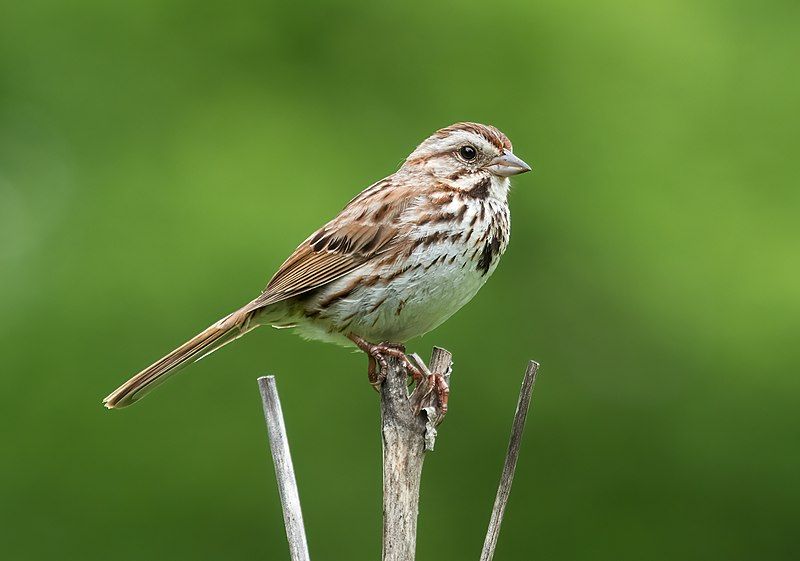
The Song Sparrow, Melospiza melodia, is a medium-sized sparrow common across North America. It has a streaked brown appearance, with a distinctive spot in the center of its chest.
Song Sparrows are highly adaptable and inhabit various environments, including marshes, fields, and suburban areas. Their diet consists of seeds, fruits, and insects.
The Song Sparrow is celebrated for its melodious song, which varies regionally but typically includes a series of clear whistles and trills. This bird’s song is one of North American nature’s most familiar and sweetest sounds, often heard throughout the day.
| Kingdom | Animalia |
| Phylum | Chordata |
| Clade | Dinosauria |
| Class | Aves |
| Order | Passeriformes |
| Family | Passerellidae |
| Genus | Melospiza |
| Species | M. melodia |
47. Northern Flicker (Colaptes auratus)
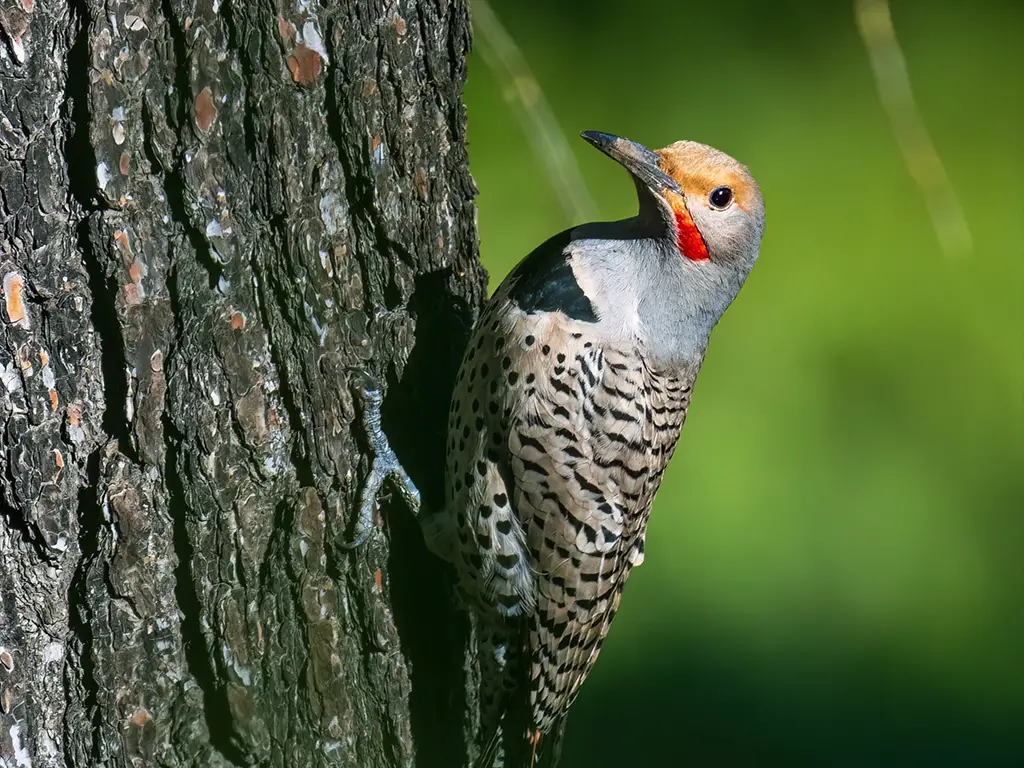
| Kingdom | Animalia |
| Phylum | Chordata |
| Clade | Dinosauria |
| Class | Aves |
| Order | Piciformes |
| Family | Picidae |
| Genus | Colaptes |
| Species | C. auratus |
Conclusion
As winter’s grip loosens and the first signs of spring emerge in Minnesota, the diverse array of winter birds begin their next journey, whether it’s migrating to distant breeding grounds or adapting to the changing season within the state.
Observing these 47 bird species throughout the winter months offers a unique window into the resilience and beauty of nature amid the cold and snow.
Each bird, from the tiny kinglets to the majestic eagles, plays a vital role in Minnesota’s ecosystems. Their presence enlivens the stark winter landscape, providing joy and intrigue to birdwatchers and nature lovers.
As they depart or transform with the season, they leave behind memories of winter’s natural splendor.